You are using an out of date browser. It may not display this or other websites correctly.
You should upgrade or use an alternative browser.
You should upgrade or use an alternative browser.
SherryLion
New Head-Fier
Pros: 1. Too much power for a small device
2. Sound quality leans towards a spacious neutral sound with good tonal accuracy
2. Sound quality leans towards a spacious neutral sound with good tonal accuracy
Cons: 1. The display is too small for this big of a device.
Review Of The Quloos MUB1

Introduction
Quloos, a Chinese firm also known as ShenZhen QLS Electronic Technology Co., Ltd, is devoted to offering high-end digital audio player research and development and has created a line of digital audio players. The firm also has an interest in various audio accessories such as audio power purifier filters and Analog to SPDIF converters. They have developed devices such as QA662, QP02, and QU02, and are commonly known as MC01 and MC01, but the most recent one that I was able to get my hands on is their new Bluetooth DAC/AMP known as the MUB1 for review, but before we get into the sound, I would want to clarify a few points.

Disclaimer
**Since this unit tour was organised by the grateful people at ConceptKart, I am grateful to them. And as I've said in all of my evaluations, the same is true for this one: all of the concepts I've expressed below are entirely my own, original ideas that haven't been influenced by anyone else. If interested, go to this link.
*I am not associated with the connection, and I receive no financial assistance from anyone.
*For the remainder of the review, I will refer to this device as “MUB1”
*Finally, I will only evaluate the MUB1 based on their performance, even though I will explain how it feels and seems physically and aesthetically.
Specification
The Quloos MUB1 is equipped with four CS43198 chips from Cirrus Logic, which provide exceptional specifications, including a Signal-to-Noise Ratio (SNR) of 132dB and incredibly low Total Harmonic Distortion plus Noise (THD+N) of 0.0001%. The device offers unique functionalities that cater to audiophiles and music enthusiasts, including a Nos mode and an eight-channel Digital-to-Analog Converter (DAC) design. These features allow the MUB1 to support high-resolution audio formats, such as PCM up to 32-bit/384kHz and Direct Stream Digital (DSD) resolution up to 256. The MUB1 also boasts advanced technology like a low jitter range, an independent power supply system, and a four-stage HiFi structure. Its construction with premium components like Panasonic Electrolytic Capacitors, Wurth Alloy Inductor, and BUF634, commonly used for desktop AMPs, are implemented efficiently.
Below is an image providing other technical specifications:
| Input Interface : | Typc -C USB data ,Type -C USB power &charging ,wire-less Bluetooth | |
| Bluetooth Format : | Bluetooth 5.0,LDAC ,APTX ,APTX -HD ,AAC ,SBC | |
| USB Protocol : | UAC2.0 protocol /UAC1.0 protocol ,support Windows , Mac ,Android ,ios system | |
| USB Port DSD Sample Rate : | 2.8224MHz(DSD64 ),5.6448MHz(DSD128 ),11.2896MHZ(DSD256 ),Native or DoP | |
| USB Port PCM Sample Rate : | 16Bit~32Bit,44.1kHz~384kHZ | |
| THD +N (AES17 (20kHz),A -Weighted ,no -load ,Mid -gain ): | Balanced :0.0001% | Single -ended :0.00015% |
| SINAD (AES17 (20kHz),A -Weighted ,no -load ,Mid -gain ): | Balanced :120dB | Single -ended :116dB |
| Dynamic Range (A -Weighted ,Mid -gain ): | Balanced :132dB | Single -ended :126dB |
| Output Power (THD +N <0.01%,S -gain ): | Balanced :110mW+1100mW@320/250mW+250mW@3000 | Single -ended :410mW+410mW@320/65mW+65mW@3000 |
| Noise Floor (AES17 (20kHz)/High Performance Sine Analyzer Disabled /A -Weighted ): | Balanced : 1.2uVms@G =L /1.2uVms@G =M /2.5uVms@G =H /8.3uVms@G =S | Single -ended : 1.8uVms@G =L /1.8uVms@G =M /2.5uVms@G =H /5.8uVms@G =S |
| Output Connector : | 3.5 single -ended &4.4balanced headphone (can be set to Line out /Aux out ) | 3.5 Optical or Coaxial SPDIF Digital Output |
| Optical /Coaxial output : | 16Bit~24Bit,44.1kHZ~192kHZPCM ,DoP64 | |
| DAC chip : | CS43131 *4pcs,QFN large package | |
| Headphone Chip : | BUF634 for desktop headphone *4pcs | |
| OP : | Selected Moist ,Excellent Music Sense OP *2pcs |

Design And Aesthetics
The MUB1 has the feel of a little square slab of metal with rounded corners, which appears small for a DAP but not for a dongle dac, hence I do not consider it a real dongle DAC/AMP. The device is made of silver aluminum and features a black front with a screen in its middle. Even being such a little device, it has a surprising number of functionality. Also, considering its appearance and body dimensions, I believe it resembles a power bank or utility gadget. Below are the device's technical specs.
| Body Size : | 96*65*14.5mm(L *W *H ) |
| Mainframe Weight : | 142g |

Usage
First, I'd want to discuss the clicking sound it produces when it turns on or when the options it gives change since it sounds the most pleasant and minimalistic. Despite its larger size compared to other pocketable DAC/AMPs, the device is rather practical and easy to use or take out of pockets. Though the plastic cover made it difficult to operate the button, it was otherwise functional. With all of the capabilities, I could utilize the gain, filter, and volume, but it was simple to go through all of the settings. Using it simply at high gain was sufficient to drive hard-to-drive IEMs such as my Prestige LTD and Crimson. The positioning of the output ports below the device was a good idea since it made it simpler to control both the device connected to the source and the device itself, but I usually used it with Bluetooth, which was rather efficient for me and my usage preferences.

Sound Impressions
IEMs
Thieaudio Prestige LTD
Prestige LTD is the very reason I am now able to find the truth in my musical dreams; I have never heard another IEM that ploughs your ears with faith in each note, no matter how those notes should sound and nurtures your senses with dynamics and presentation as if I were hearing reality. Previously, I owned the Monarch MKII, which established what one would expect, but once the prestige's magic began to flourish, I knew I could explore so much more with it, especially when it came to the air and presence of each nuance the notes were able to grasp over and tingled my senses. To summarise the prestige's response sounds as if the Monarch MKII were given steroids and enhanced the upper frequencies in all directions with better authoritative flow in the lower response. The response is neutral with sub bass boost, similar to the Monarch MKII, with the exception that the notes are airier and more revealing than any other IEM before this era. However, the thinner notes and excessive clarity provide obnoxious features that expose bad mixing and recordings, which were highly obvious when heard on my V6 but smoothed out on my WM1A, indicating source dependence.

While listening to LTD with MUB1, the response seemed more controlled and mature, with better control over the treble energy, which sounded somewhat more bodied and tonally warmer. The stage is large enough to provide a better holographic reaction, and the image has improved, resulting in a more engaging response. The voices are slightly soft, and the instruments seem rounded, but the wide and airy response is not impaired. Another thing that stood out was that the female voices, which were capable of showing air and realistic features in the high octaves, faded, and the instruments were somewhat limited in their ability to expose maximum clarity. The bass did not appear to be significantly altered, and it retained its punch and weight within the mix.
Symphonium Crimson
I have come across the Crimson IEMs and I have to say that they are a cut above my best-sounding IEM, the Prestige LTD. The Crimson provides an incredibly enjoyable experience, surpassing any other IEMs I have heard, whether they are top-of-the-line or not. The Crimson’s presentation is expressive yet smooth, with a balanced and warm response that accurately reproduces the quality of the notes while providing a playful presentation of the vocals and instruments. The newer BA IEMs can sound less metallic or artificial, but Symphoniom has gone above and beyond in this regard. I have previously thought that the Helios offered better detail retrieval than the Thieaudio Monarch MKII, but I preferred the Monarch MKII’s pleasing tonality, which became my favourite at the time. However, the Crimson has now generously offered everything I wanted and more, including the weight and impact of the bass, and the musicality in the presentation of the vocals and instruments in the upper frequencies while retaining a pleasing tonality.

During my listening experience with the Crimson and MUB1, I couldn’t help but notice how the response of the sound felt soft and rounded. While the detailed aspects of the notes were not as prominent, there was an improved grasp over the tonal quality which made the listening experience quite enjoyable. Another aspect that stood out was the spaciousness of the response, which allowed the vocals to sound open and free. Additionally, the treble felt extensive and airy, while the bass took a backseat in terms of power and impact, resulting in a sound that was warmer and more mellow than before. Overall, the listening experience was quite pleasant.
Thor Mjolnir MKII
Mjolnir is a very bassy set that has a lot of sub-bass emphasis. The treble and upper mid-range are also very forward in the mix. The upper treble has great extension as well. The bass is very punchy and boomy while acting fast. Mjolnir is a great V-shape-sounding IEM with a different approach to explosive bass that has better technicalities, especially in this price range. The stage is great with a nice surrounding stage and depth where the separation of each element sounds distant enough to procure space to breathe and distinguish themselves. The attack and decay of the driver capability are really quick and perform great. The vocals may feel lean and sparkly, but the warmth or the fuller experience is something that these lack. The bass response does vary from source to source whether I listen to a warm source or a neutral one, the bass becomes either overwhelming authoritative or both.

With this combo, the upper midrange and lower treble sounded more front, while the voices and instruments sounded leaner and forward, resulting in an open and energetic response. However, the bass felt more accurate and controlled. Finally, delivering an enthusiastic reaction with engaging voices and entertaining instrumental presentation improves the sound's detail and clarity.
Tin Hifi P1 Max II
Based on my recollection, the previous version of the P1 MAX II, the P1 Max, had a warm and neutral sound that produced a pleasing response with rounded notes and a safe response. However, the P1 Max II takes that safe tuning and adds more detailed aspects to the sound. Compared to its predecessor, the P1 Max II has a more balanced response with an emphasised mid-range. This results in a more engaging and lively sound. In today's world of Planar IEMs, many companies have started using this technology and released successful products. This has led to a highly competitive market, with each company striving to excel in their technology and tuning on planar drivers. Despite this, I believe that the P1 Max II stands out as a unique and intriguing IEM in the market.

while listening to P1 Max II with MUB1, the response sounds a little more weighted yet transparent with a more emphasised lower mid-range bringing a better tonally balanced response. The details and clarity are somewhat improved and the notes sound livelier. The bass impact has more oomph and meat in the mid-bass yet the impact is still light. The overall response is more enjoyable and natural sounding.
Kiwi Ears X Crinacle Singolo
The Singolo's tuning tends toward a naturally warm tone that becomes increasingly pleasurable to listen to with each second. The bass response is optimized to sound larger, bodied, and genuine. Whatever I said, it wouldn't have mattered if the technology that the corporation was pleased to deliver to us wasn't effective. But, after giving it a good amount of time to understand and find logic, the only thing I was able to understand was that the driver used is of high quality, as is the use of the K.A.A.R.S technology, which is the implementation of acoustic tuning from the back of the driver to accentuate the air pressure, allowing for a dip around 200Hz-400Hz without affecting the natural tone that resides in that region. The whole response sounds genuine, lively, and right in every manner conceivable. The only issue I have is with the treble, yet it is what makes the Singolo sound great.

While listening to Singolo with MUB1, the overall response was distinct and resolved, with a significant emphasis in the mid-range region, which enhanced the voice impression and delivered a more clear, crisp, and transparent sound; the same can be said for the instruments, though the impact of the notes was not as powerful. The treble seemed more apparent, with better nuances, but the air and extension felt same. In comparison, the bass appeared less alive in the mix, but it was precise and well-controlled. The complexities were quickly disclosed, but their impact lacked the brilliance of the notes and their powerful presence.
Tracks
Millet - Anytime Anywhere
Anri - I can’t stop the loneliness
Kohana Lam - A Few Sentimental
Kohana Lam - Loving Me, Loving You
Uru - Kimino Shiawasewo
Uru - Kamihitoe
Kujira Yumemi - Kenka
Majiko - Kokoronashi
Anly - Sukinishinayo
Kohama Lam - A Few Sentimental
Kohana Lam - Loving Me, Loving You
Miliyah - Kono Yumega Samerumade
Rokudenashi - The Flame Of Love
Yu-Peng Chen - A New Day with Hope
Yu-Peng Chen - Another Hopeful Tomorrow
Yu-Peng Chen - For Riddles, for Wonders
Valentino Khan - Satellite
Kai Wachi - Happier By Now
Jawns - Erotica
ISOxo - how2fly
Kai Wachi - Happier By Now
Weeknd - Popular
YUNGBLUD - When We Die(Can We Still Get High)
Bring to Horizon - Kool-Aid
Middle Kids - Bend
FLETCHER - Leads Me On
Loathe - Aggressive Evolution
The Weeknd - Save Your Tears
Sigrid - Burning Bridges
AURORA - Black Water Lilies
AURORA - Runaway
X Ambassadors - Renegades
Lupe Fiasco - Words I Never Said
Macklemore & Ryan Lewis - Can’t Hold Us
Gotye - Somebody That I Used To Know
Jay-Z - Run This Town
Lady Gaga - Poker Face
Lady Gaga - Just Dance
Ladytron - Ghost
Travis - Love Will Come Through
LINKIN PARK - Somewhere I Belong
DJ Shadow - Six Days (Remix)
Hoobastank - The Reason
Ricky Martin - I Don’t Care
Tool - 7empest
Tool - Vicarious
A Flock Of Seagulls - Space Age Love Song
Zack Hemsey - Vengeance
Elton John - I’m Still Standing
The Moody Blues - Nights In White Satin
Micheal Sembello - Maniac
Guns N’ Roses - Sweet Child O’ Mine
A.R. Rahman - Kun Faya Kun
Conclusion
In the end, I discovered this tiny piece of hardware packed with a lot of capabilities and power, and it eventually offers a superb sound quality to listen to whether IEMs or headphones, because it is so powerful. The way it is tuned is really incredibly clear and precise, giving you a specific place to scowl on and live with the music you purchased this device for. Given that they truly represent a revolution, they definitely receive a ten out of ten recommendation.

Last edited:
hitchhiker
New Head-Fier
Pros: Versatile input and output options
Very usable gain
Functional filters
Femtosecond clock
Excellent option as DDC
Very usable gain
Functional filters
Femtosecond clock
Excellent option as DDC
Cons: Display and controls take a bit of getting used to
Quloos - MUB1 - Quick Impressions
Thanks to Concept Kart (https://conceptkart.com/products/quloos-mub1-bluetooth-portable-usb-dac-amp) and gadgetgod for the tour unit of the Quloos MUB1 portable dacamp.As always, the views expressed in the review are mine only and are not influenced or compensated in any way by any one.
BUILD
The review unit has been going around for a while now, and it has stood up to the abuse very well, so full marks for the build of the unit.
I have tried Quloos QA390 earlier (QA390 is a all in one desktop music player/DAP that can power the most demanding of headphones without any additional devices.
I havent tested them with Susvara, but everything else I threw at it, it drove it wonderfully!) and had the impression of a very beautifully balanced sound, with
excellent technicalities as well as balanced sound.
Hence the MUB1 also comes with those sort of expectations. The review unit came with a transparent silicone cover and nothing else. The unit has a small LCD (maybe monochrome led?)
display that is quite minimal in terms of readout.
The device has 2 USB C ports, one for charging only, and the other that does dual duty of charging as well as receiving digital data.
There is a 3.5mm output jack as well as a 4.4mm balanced out. The device also has a spdif/optical out, for DDC purposes. As the device also has a built in
femtosecond clock, this is a very good option for clean input to more sensitive devices.
The input is also BT enabled, for streaming from a source bt device such as a phone or streamer, and similar to the usecase of the BTR devices from FIIO.
USAGE/POWER IN THE REALWORLD
To test the gain options (Low, Medium, High, Super), I tried mutliple transducers - sensitive iems, single DDs that scale, planars that are hard to drive, headphones that test the amp sectionsand the MUB1 was able to drive them well.
For sensitive iems (some older micro drivers and BA iems), in the Low Gain mode, there was no hissing, excellent sound without noise in the background
* Single DDs were able to use the gain (High) very well, with excellent performance.
* Planars were driven well with top performance.
* Hard to drive headphones (vintage Sennheisers HD650) were driver very well in the Super gain mode.
Filters actually make a difference, similar to the QA390. NOS mode is very true to the original mastering, while fast and slow rolloff filters were very usable and produced perceptible change in the sound.
Fast rolloff provided for very quick decay, while there was adequate sustain with the slow rolloff filters, making the sound more analog.
COMPARISONS WITH QUESTYLE CMA18
The CMA 18 in comparison, provides similar options, but run hotter. However, the CMA18 has an additional ADC mode which allows for recording audio.Both have excellent performance overall and offer true high end value to discerning audiophiles looking for portable options.
CONCLUSION
The MUB1 is an excellent portable dacamp that provides high end sound in a portable form. The device didnt heat up after a lot of usage even in a hot 38 celcius environment.Sonic Sleuth
New Head-Fier
Pros: Versatile functionality: Functions as a portable USB DAC/Amplifier, Bluetooth player, and power bank.
High-quality construction: Premium materials and sleek design with glass panels and CNC machined aluminum alloy frame.
Impressive sound performance: Natural and balanced sound signature with powerful bass, detailed mids, and smooth treble.
Extensive connectivity: Supports multiple digital and analog input/output options, including USB Type-C, 3.5mm, and 4.4mm.
Strong Bluetooth connectivity: Supports high-resolution codecs like LDAC and AptX HD, with minimal latency and reliable range.
Long battery life: Up to 10 hours of playback time, with the added ability to charge other devices.
High-quality construction: Premium materials and sleek design with glass panels and CNC machined aluminum alloy frame.
Impressive sound performance: Natural and balanced sound signature with powerful bass, detailed mids, and smooth treble.
Extensive connectivity: Supports multiple digital and analog input/output options, including USB Type-C, 3.5mm, and 4.4mm.
Strong Bluetooth connectivity: Supports high-resolution codecs like LDAC and AptX HD, with minimal latency and reliable range.
Long battery life: Up to 10 hours of playback time, with the added ability to charge other devices.
Cons: Price: Relatively high price point compared to some competitors.
Learning curve: Navigation and settings adjustment may require some time to master due to the small OLED screen and hardware buttons.
Limited accessories: While it includes essential cables and a silicone case, additional accessories like the leather case are sold separately.
Size and weight: While portable, it may be slightly larger and heavier compared to some similar devices.
Burn-in period: Requires some burn-in time to optimize sound performance, which may not be ideal for immediate use out of the box.
Learning curve: Navigation and settings adjustment may require some time to master due to the small OLED screen and hardware buttons.
Limited accessories: While it includes essential cables and a silicone case, additional accessories like the leather case are sold separately.
Size and weight: While portable, it may be slightly larger and heavier compared to some similar devices.
Burn-in period: Requires some burn-in time to optimize sound performance, which may not be ideal for immediate use out of the box.
I would like to thank @gadgetgod and ConceptKart for sending this unit as part of the review tour.
You can purchase it from ConceptKart at the following link (not an affiliate link):
https://conceptkart.com/products/quloos-mub1-bluetooth-portable-usb-dac-amp
Also, I’m not a seasoned reviewer or a seasoned audiophile, so whatever I say are purely my observations and your results may vary.
I’m not the one to usually focus on specifications and numbers. I focus more on how happy I am with the equipment’s sound and that’s it.
Introduction:
Quloos, formerly QLS HiFi, based in ShenZhen, China, specializes in high-end audio equipment. Their latest offering, the MUB1, is an all-in-one portable audio solution. Compact yet powerful, it functions as a USB DAC/Amp.
Physical Unit:
The MUB1 boasts a sleek aluminum alloy shell with glass panels, housing four high-performance 32-bit DAC chips and amp chips. It features a small OLED screen, hardware buttons for controls, and various output options, all packed into a pocket-friendly design.




Specifications:
Equipped with CS43131 decoding chips, the MUB1 supports high-resolution audio up to 32-Bit/384kHz PCM and Native DSD256. It offers multiple digital filters and a balanced headphone amp architecture with impressive power output.
Dynamic Range (Balanced/Single-ended)
132dB/126dB
Output Power (Balanced/Single-ended)
1100mW+1100mW@32Ω/250mW+250mW@300Ω
410mW+410mW@32Ω/65mW+65mW@300Ω
Battery life and usage:
The MUB1 boasts a 2500mAh battery that provides up to 10 hours of playback time. It features two USB Type-C ports, one for charging and another for digital input or power bank function. The device can charge other devices connected to it, making it a versatile companion for extended listening sessions on the go. Additionally, users can bypass the battery and power the MUB1 directly from the charging port, enhancing its long-term battery health and lifespan.
In real-world usage, the MUB1 delivers impressive battery performance. When using the 3.5mm single-ended output, it consistently provides approximately 9.5 to 10 hours of playback time at high gain. Similarly, with the 4.4mm balanced output, users can expect around 7.5 to 8 hours of playback time at high gain.


Sound:
I want to outright mention that this is the best implementation of CS43131 chips I’ve come across till date.
The MUB1 delivers a balanced and natural sound signature across the frequency range. Its bass is deep and controlled, midrange rich and detailed, and treble natural and crisp. The soundstage is spacious and immersive, akin to desktop devices.
Sound Performance in Bluetooth Mode:
The MUB1 surprises with its exceptional sound quality when connected via Bluetooth to compatible devices such as smartphones or tablets. Utilizing advanced codecs like LDAC, AptX HD, and AptX, the MUB1 maintains a level of sonic fidelity close to its performance in USB DAC mode. While some minor loss of dynamics and micro details may occur, the overall sonic experience remains impressive, surpassing many other Bluetooth devices in its class. Users can enjoy rich bass, transparent midrange, and smooth treble reproduction, making wireless listening a satisfying experience.
Sound Performance in USB DAC/AMP Mode:
When used as a USB DAC/AMP, the MUB1 showcases its full potential, delivering an outstanding audio performance that rivals desktop setups. With its quad CS43131 DAC configuration and meticulously designed balanced audio circuitry, the MUB1 offers exceptional clarity, detail retrieval, and tonal accuracy. The device handles various music genres with ease, delivering deep, controlled bass, natural and organic midrange, and refined, non-fatiguing treble. Its spacious soundstage and precise imaging further enhance the listening experience, providing users with a captivating and immersive sonic journey.
Tonality and Timbre:
With a realistic and organic timbre, the MUB1 excels in both instrument and vocal reproduction. It strikes a perfect balance between analytical and analog, providing vibrant and lifelike performances.
Bass:
The MUB1 impresses with its natural and powerful bass response, offering depth and impact across various music genres. It handles complex bass passages with texture and control, enhancing the listening experience.
Vocals:
From male to female vocals, the MUB1 excels in transparency and engagement. It reproduces voices with natural body and depth, making performances captivating and lively.
Treble:
The MUB1's treble performance is smooth and detailed, with a touch of warmth. It maintains clarity and definition throughout the frequency range, avoiding harshness or congestion.
Conclusion:
In conclusion, the Quloos MUB1 is a versatile and powerful portable audio solution that excels in sound quality, convenience, and functionality.
You can purchase it from ConceptKart at the following link (not an affiliate link):
https://conceptkart.com/products/quloos-mub1-bluetooth-portable-usb-dac-amp
Also, I’m not a seasoned reviewer or a seasoned audiophile, so whatever I say are purely my observations and your results may vary.
I’m not the one to usually focus on specifications and numbers. I focus more on how happy I am with the equipment’s sound and that’s it.
Introduction:
Quloos, formerly QLS HiFi, based in ShenZhen, China, specializes in high-end audio equipment. Their latest offering, the MUB1, is an all-in-one portable audio solution. Compact yet powerful, it functions as a USB DAC/Amp.
Physical Unit:
The MUB1 boasts a sleek aluminum alloy shell with glass panels, housing four high-performance 32-bit DAC chips and amp chips. It features a small OLED screen, hardware buttons for controls, and various output options, all packed into a pocket-friendly design.




Specifications:
Equipped with CS43131 decoding chips, the MUB1 supports high-resolution audio up to 32-Bit/384kHz PCM and Native DSD256. It offers multiple digital filters and a balanced headphone amp architecture with impressive power output.
Dynamic Range (Balanced/Single-ended)
132dB/126dB
Output Power (Balanced/Single-ended)
1100mW+1100mW@32Ω/250mW+250mW@300Ω
410mW+410mW@32Ω/65mW+65mW@300Ω
Battery life and usage:
The MUB1 boasts a 2500mAh battery that provides up to 10 hours of playback time. It features two USB Type-C ports, one for charging and another for digital input or power bank function. The device can charge other devices connected to it, making it a versatile companion for extended listening sessions on the go. Additionally, users can bypass the battery and power the MUB1 directly from the charging port, enhancing its long-term battery health and lifespan.
In real-world usage, the MUB1 delivers impressive battery performance. When using the 3.5mm single-ended output, it consistently provides approximately 9.5 to 10 hours of playback time at high gain. Similarly, with the 4.4mm balanced output, users can expect around 7.5 to 8 hours of playback time at high gain.


Sound:
I want to outright mention that this is the best implementation of CS43131 chips I’ve come across till date.
The MUB1 delivers a balanced and natural sound signature across the frequency range. Its bass is deep and controlled, midrange rich and detailed, and treble natural and crisp. The soundstage is spacious and immersive, akin to desktop devices.
Sound Performance in Bluetooth Mode:
The MUB1 surprises with its exceptional sound quality when connected via Bluetooth to compatible devices such as smartphones or tablets. Utilizing advanced codecs like LDAC, AptX HD, and AptX, the MUB1 maintains a level of sonic fidelity close to its performance in USB DAC mode. While some minor loss of dynamics and micro details may occur, the overall sonic experience remains impressive, surpassing many other Bluetooth devices in its class. Users can enjoy rich bass, transparent midrange, and smooth treble reproduction, making wireless listening a satisfying experience.
Sound Performance in USB DAC/AMP Mode:
When used as a USB DAC/AMP, the MUB1 showcases its full potential, delivering an outstanding audio performance that rivals desktop setups. With its quad CS43131 DAC configuration and meticulously designed balanced audio circuitry, the MUB1 offers exceptional clarity, detail retrieval, and tonal accuracy. The device handles various music genres with ease, delivering deep, controlled bass, natural and organic midrange, and refined, non-fatiguing treble. Its spacious soundstage and precise imaging further enhance the listening experience, providing users with a captivating and immersive sonic journey.
Tonality and Timbre:
With a realistic and organic timbre, the MUB1 excels in both instrument and vocal reproduction. It strikes a perfect balance between analytical and analog, providing vibrant and lifelike performances.
Bass:
The MUB1 impresses with its natural and powerful bass response, offering depth and impact across various music genres. It handles complex bass passages with texture and control, enhancing the listening experience.
Vocals:
From male to female vocals, the MUB1 excels in transparency and engagement. It reproduces voices with natural body and depth, making performances captivating and lively.
Treble:
The MUB1's treble performance is smooth and detailed, with a touch of warmth. It maintains clarity and definition throughout the frequency range, avoiding harshness or congestion.
Conclusion:
In conclusion, the Quloos MUB1 is a versatile and powerful portable audio solution that excels in sound quality, convenience, and functionality.
Attachments
Lambo970
Would love to try this sometime soon. And I guess MUB1 is actually not that big compare to those competitors with battery? Like Q15, CMA18P, etc.
Sonic Sleuth
It is very similar in size when compared to CMA18P however Q15 is much larger and heavier.
nihalsharma
500+ Head-Fier
Pros: * Decent sound performance with nice tonality
* Loaded with features: gain, filters, bluetooth.
* A powerful output that can do justice to most of iems
* Sleek and compact design, lightweight, and extremely portable
* Decent Battery life
* Exceptional price-to-performance ratio
* Loaded with features: gain, filters, bluetooth.
* A powerful output that can do justice to most of iems
* Sleek and compact design, lightweight, and extremely portable
* Decent Battery life
* Exceptional price-to-performance ratio
Cons: * Nothing much
Quloos, a well-known Chinese brand, is celebrated for its wide array of high-quality audio products. My introduction to the brand came through MUB1, a dac/amp unit. Prior to experiencing this little wonder firsthand, I came across commendations for this compact device and decided to dig deeper into both the product and the brand itself. Among their notable offerings from the brand is the QA390LE, which has also received acclaim for its exceptional quality from various people.
Concept Kart, a local online store in India, sent me the MUB1 for an audition. MUB1 sells for nearly 500 USD. It can be bought here. Link

Rating Criteria:
I want to lay out my rating criteria before we start off. For me, the primary criterion for evaluating audio gear is its intrinsic value rather than its price tag. A higher price doesn't always correlate with superior quality, and similarly, a low-priced product can give enough listening pleasure for it to be called outstanding. I consider the build, features, and, most importantly, the impact on the listening experience. The fundamental purpose of audio gear is to enhance the listening experience. So for me, this degree of enhancement in the listening experience is a key determinant in rating a product.
Rating below 4: I really won't be posting reviews of such items unless someone has asked for them.
Rating of 4: The product is good, and some users may find it more satisfactory, but it does come with a few caveats, such as price, fit, etc.
Rating of 4.5: The product is excellent and comes with an easy recommendation, reflecting its high quality and overall positive attributes.
Rating of 5: This product can be deemed groundbreaking, a trendsetter, and an eye-opener and deserves a spot on everyone's list due to its exceptional features and outstanding performance.

Product Features:
MUB1 boasts a plethora of features, rendering it an exceedingly valuable device. It encompasses all the essential functionalities one could think of within its price range. To begin with, it harnesses the power of four CS43131 DAC chipsets, for delivering exceptional sound quality characterized by high resolution and refined tones, along with an impressive signal-to-noise ratio.
Inputs: There is a USB type-C data source where you can connect your devices for listening. The other USB-C port is for charging. It also takes data input via Bluetooth, supporting the 5.0 BT protocol. The BT connection uses some advanced features to stream with decent sound. The BT connection is quite strong and does not drop.
Gains: There are 4 types of gain modes. Low, Medium, High, and Super High gain modes. For iems, high gain mode is more than enough. One can use super high gain with more power-hungry headphones as the output is nearly 3–4 times that of high gain.
Filters: MUB1 offers five different types of filters. While these filters have quite subtle differences, it's good to have options. I used the MUB1 mostly with the NOS filter. Its the most relaxed of all.
Outputs: There is a 3.5mm and a 4.4mm balanced output. The 4.4 balanced output can be set to line out. There is a 3.5 mm optical or coaxial SPDIF digital output too.
Design: MUB1 is quite compact and has a very sleek design factor. It is very lightweight, and its dimension is not an issue when carrying a smartphone. The build feels quite premium, and the device gives a good, solid feel when you hold it. All the functional buttons are on the right side of the device, and the lower side has input and output ports.
Battery: There are separate charging and data slots. For charging, it takes a 5V/2A power supply. The battery life is very decent and can go up to nearly 8 hours on the balanced output. I could not time the battery life, though. To give a good and long life to the battery, there is an option where, when you connect the device to a charger, you can bypass the battery and power the MUB1 directly from the charging port.

Sound Analysis:
MUB1 is a little powerhouse with a very impressive sound and great tonality. The sound is warm and smooth, with some decent bass presence, a sweet midrange, and controlled highs.
The bass on MUB1 is quite decent. Its well layered and has a good texture to it. The subbass has a good body and depth. The bass is tight and precise, with a good impact, and does not intrude on the higher frequencies.
The midrange has a very natural feel, and there is a nice tonal weight to it. The mids are sweet, as per my liking, and the resolution is very decent. Both male and female vocals have good texture and sound quite full. Midrange instruments like piano, string, etc. have decent weight and extension. The upper mids have a good amount of energy and do not get shouty at all. There is no thinness in the upper mids.
The upper frequency is quite controlled and smooth. There is no sharpness or unwanted peakiness, making it ideal for longer sessions. There is good detailing and extension. However, the sense of airiness is not quite pronounced.
In terms of technical aspects, MUB1 performs above average. The soundstage is not as wide but is not even intimate. The depth is quite decent. The separation of instruments in complex musical passages is very decent, and there is no congestion.

Comparisons and pairings:
The only other similar device I could compare the MUB1 with was the Earmen Angel. Angel is more powerful than the MUB1. It hosts an ESS DAC, ES9038Q2M chip. Angel has a neutral sound signature with a hint of brightness. The soundstage on Angel is wider than that of MUB1, and the depth is almost similar.
The natural and organic tonality of MUB1 is more to my liking than the analytical and rather cold signature of Angel. Angel pairs well with warmer iems and adds a sense of airiness. Angel can drive some power-hungry headphones and iems quite well where MUB1 can lack a bit. Angel does not have Bluetooth. Also, MUB1 has buttons to pause, play, and skip tracks, which are not there in Angel. So, in terms of usability, MUB1 can appeal to a lot of people.
Pair up:
64Audio Fourte: I absolutely love how MUB1 handles the Fourte. Its controlled and refined highs create a perfect synergy with the Fourte's nearly-bright character. Mids sound sweeter on the MUB1. The mids are rendered with a delightful sweetness on the MUB1. Personally, I refrain from using the Fourte with Angel as it tends to increase its brightness. With Fourte, there is a slight static hiss likely due to Angel's higher power output. However, I really wish that headstage was a bit better with the MUB1. I found it limiting the true potential of Fourte. I used the NOS filter for the Fourte, which dealt with the upper frequencies the best.
Kinera Verdandi: Verdandi is a power-hungry iem and scales quite a bit with a powerful amp section. MUB1 handles the Verdandi really well; however, the Angel does more justice to it. On Angel, the Verdandi sounds more open, and the headstage is better, thus creating a more expansive audio experience. The output on Angel shows a good sense of airiness, with improved bass impact compared to MUB1.
Among the less power-hungry iems, my preference leans strongly towards MUB1. Its natural tonality significantly enhances its musical character. One reason to avoid Angel with sensitive iems is because of the static hiss in the background. Angel performs really well with iems having a warm signature and higher power demands; otherwise, it tends to sound overly analytical in many instances.

Conclusion:
The MUB1 stands out as an exceptional device, offering a comprehensive range of features within its compact form. It sounds amazing. It has a great battery life. It is powerful enough to fire up most of the iems and decent-sized cans. MUB1 effectively renders any potential use case for a dongle, especially the more expensive ones, obsolete. While its price may be higher compared to most dongles, its unparalleled performance justifies the investment. In my opinion, no other dongle can match the exceptional sound quality of the MUB1. It can also give a good fight to some more powerful dac/amps. I cannot find anything that is missing with the MUB1. It gets a solid recommendation from me. A true 5/5 device.
Concept Kart, a local online store in India, sent me the MUB1 for an audition. MUB1 sells for nearly 500 USD. It can be bought here. Link

Rating Criteria:
I want to lay out my rating criteria before we start off. For me, the primary criterion for evaluating audio gear is its intrinsic value rather than its price tag. A higher price doesn't always correlate with superior quality, and similarly, a low-priced product can give enough listening pleasure for it to be called outstanding. I consider the build, features, and, most importantly, the impact on the listening experience. The fundamental purpose of audio gear is to enhance the listening experience. So for me, this degree of enhancement in the listening experience is a key determinant in rating a product.
Rating below 4: I really won't be posting reviews of such items unless someone has asked for them.
Rating of 4: The product is good, and some users may find it more satisfactory, but it does come with a few caveats, such as price, fit, etc.
Rating of 4.5: The product is excellent and comes with an easy recommendation, reflecting its high quality and overall positive attributes.
Rating of 5: This product can be deemed groundbreaking, a trendsetter, and an eye-opener and deserves a spot on everyone's list due to its exceptional features and outstanding performance.

Product Features:
MUB1 boasts a plethora of features, rendering it an exceedingly valuable device. It encompasses all the essential functionalities one could think of within its price range. To begin with, it harnesses the power of four CS43131 DAC chipsets, for delivering exceptional sound quality characterized by high resolution and refined tones, along with an impressive signal-to-noise ratio.
Inputs: There is a USB type-C data source where you can connect your devices for listening. The other USB-C port is for charging. It also takes data input via Bluetooth, supporting the 5.0 BT protocol. The BT connection uses some advanced features to stream with decent sound. The BT connection is quite strong and does not drop.
Gains: There are 4 types of gain modes. Low, Medium, High, and Super High gain modes. For iems, high gain mode is more than enough. One can use super high gain with more power-hungry headphones as the output is nearly 3–4 times that of high gain.
Filters: MUB1 offers five different types of filters. While these filters have quite subtle differences, it's good to have options. I used the MUB1 mostly with the NOS filter. Its the most relaxed of all.
Outputs: There is a 3.5mm and a 4.4mm balanced output. The 4.4 balanced output can be set to line out. There is a 3.5 mm optical or coaxial SPDIF digital output too.
Design: MUB1 is quite compact and has a very sleek design factor. It is very lightweight, and its dimension is not an issue when carrying a smartphone. The build feels quite premium, and the device gives a good, solid feel when you hold it. All the functional buttons are on the right side of the device, and the lower side has input and output ports.
Battery: There are separate charging and data slots. For charging, it takes a 5V/2A power supply. The battery life is very decent and can go up to nearly 8 hours on the balanced output. I could not time the battery life, though. To give a good and long life to the battery, there is an option where, when you connect the device to a charger, you can bypass the battery and power the MUB1 directly from the charging port.

Sound Analysis:
MUB1 is a little powerhouse with a very impressive sound and great tonality. The sound is warm and smooth, with some decent bass presence, a sweet midrange, and controlled highs.
The bass on MUB1 is quite decent. Its well layered and has a good texture to it. The subbass has a good body and depth. The bass is tight and precise, with a good impact, and does not intrude on the higher frequencies.
The midrange has a very natural feel, and there is a nice tonal weight to it. The mids are sweet, as per my liking, and the resolution is very decent. Both male and female vocals have good texture and sound quite full. Midrange instruments like piano, string, etc. have decent weight and extension. The upper mids have a good amount of energy and do not get shouty at all. There is no thinness in the upper mids.
The upper frequency is quite controlled and smooth. There is no sharpness or unwanted peakiness, making it ideal for longer sessions. There is good detailing and extension. However, the sense of airiness is not quite pronounced.
In terms of technical aspects, MUB1 performs above average. The soundstage is not as wide but is not even intimate. The depth is quite decent. The separation of instruments in complex musical passages is very decent, and there is no congestion.

Comparisons and pairings:
The only other similar device I could compare the MUB1 with was the Earmen Angel. Angel is more powerful than the MUB1. It hosts an ESS DAC, ES9038Q2M chip. Angel has a neutral sound signature with a hint of brightness. The soundstage on Angel is wider than that of MUB1, and the depth is almost similar.
The natural and organic tonality of MUB1 is more to my liking than the analytical and rather cold signature of Angel. Angel pairs well with warmer iems and adds a sense of airiness. Angel can drive some power-hungry headphones and iems quite well where MUB1 can lack a bit. Angel does not have Bluetooth. Also, MUB1 has buttons to pause, play, and skip tracks, which are not there in Angel. So, in terms of usability, MUB1 can appeal to a lot of people.
Pair up:
64Audio Fourte: I absolutely love how MUB1 handles the Fourte. Its controlled and refined highs create a perfect synergy with the Fourte's nearly-bright character. Mids sound sweeter on the MUB1. The mids are rendered with a delightful sweetness on the MUB1. Personally, I refrain from using the Fourte with Angel as it tends to increase its brightness. With Fourte, there is a slight static hiss likely due to Angel's higher power output. However, I really wish that headstage was a bit better with the MUB1. I found it limiting the true potential of Fourte. I used the NOS filter for the Fourte, which dealt with the upper frequencies the best.
Kinera Verdandi: Verdandi is a power-hungry iem and scales quite a bit with a powerful amp section. MUB1 handles the Verdandi really well; however, the Angel does more justice to it. On Angel, the Verdandi sounds more open, and the headstage is better, thus creating a more expansive audio experience. The output on Angel shows a good sense of airiness, with improved bass impact compared to MUB1.
Among the less power-hungry iems, my preference leans strongly towards MUB1. Its natural tonality significantly enhances its musical character. One reason to avoid Angel with sensitive iems is because of the static hiss in the background. Angel performs really well with iems having a warm signature and higher power demands; otherwise, it tends to sound overly analytical in many instances.

Conclusion:
The MUB1 stands out as an exceptional device, offering a comprehensive range of features within its compact form. It sounds amazing. It has a great battery life. It is powerful enough to fire up most of the iems and decent-sized cans. MUB1 effectively renders any potential use case for a dongle, especially the more expensive ones, obsolete. While its price may be higher compared to most dongles, its unparalleled performance justifies the investment. In my opinion, no other dongle can match the exceptional sound quality of the MUB1. It can also give a good fight to some more powerful dac/amps. I cannot find anything that is missing with the MUB1. It gets a solid recommendation from me. A true 5/5 device.
Last edited:
joydivisionnewdawnfades
Great review, very curious about it compared to shanling H5/Fiio Q15 and DC elite (smaller format without battery)
noplsestar
Headphoneus Supremus
Pros: Outstanding sound performance (with USB connection)
Great sound performance when paired with Bluetooth
Very powerful device
Multiple gain options
Very beautiful design
General build quality
Great sound performance when paired with Bluetooth
Very powerful device
Multiple gain options
Very beautiful design
General build quality
Cons: In "Super Gain Mode" slightly less "black background"
A few more volume steps would have been nice
A few more volume steps would have been nice
Hi there, this is my review of the Quloos MUB1 portable DAC/amp amplifier that I did get from QLS in exchange for an honest review.
First of all when unboxing the device, it was great to see that all the needed cables as well as adapters were included. No need to spend extra money for additional lightning cables. This is not usual and therefore most welcome. Also a silicon case is included as well as a screen protector. They have clearly done their homework with that accessory!
Secondly what I really liked: The design of the MUB1. It has both a retro and futuristic, but in fact a very minimalistic design that speaks to my heart. No sharp edges, no fancy patterns on the surface but a clean design-language. Thanks for that!
When powering it up, you have everything you need on the small screen: Connection mode, loudness, gain setting, filter, battery. The menu and the handling overall is very intuitive. No need to look at the instruction manual. It is all there and easy to use. When taking it into the hand, the weight is nice, not too high, not too low. You immediately feel that this device is built like a tank. It gets a little warm when listening extensively to music, but it´s not unnaturally hot.
When I made the listening tests with my beloved AKG N700NC M2 (that follows the harman curve quite nicely), and with the Focal Bathys, I was pleasantly surprised that the Bluetooth connection is THAT good (with Samsung Galaxy s10e with LDAC as well as with my iPhone 12 with AAC). In fact the sound when connected to Bluetooth is so good that I found myself - more often than expected - using the MUB1 with Bluetooth rather than connected via USB cable. It´s just so convenient to connect the MUB1 with the headphones, put the MUB1 in the right bag of my jacket and having my mobile phone in my left trouser pocket. Yes, the soundstage might be a tiny bit smaller in BT mode and here and there there might be more micro details to be heard when connected to USB cables BUT in fact this would only be heard when listening very focused and without walking around from A to B. So that’s a very big plus for the MUB1. Everything works smoothly, no matter what connection you choose!
But what about the sound?
Well, overall I would say the MUB1 offers a natural presentation.
Beginning with the bass: Plenty of sub bass available! Mid bass is nicely present, but thankfully not so much that it would bleed into the mids. So enough rumble and power down below. Nothing to complain here, in the contrary: Very well done!
The mids are present, but I wouldn’t describe them as dead neutral. They give the voices a nice body. They are palpable and beautifully rendered so that they kind of invite me to listen to the whole tracks instead of only listening to the first thirty seconds and then skip to the next track, if you know what I mean. It is a presentation to sink into. Naturalness is the key here.
The Highs are smooth but not recessed. They are nicely extended but never too much so that it would bother you when listening to louder volumes. It reminds me a bit of my good old Calyx M DAP I head years ago. Everything is there, but not exaggerated to the point where you would only listen to the cymbals and nothing else. It offers an analogue and lifelike presentation of the higher frequencies.
Plenty of dynamics (macro as well as micro) to be heard with the MUB1! The soundstage is surprisingly big, where I hear a bit more width than depth. Those technicalities improve again a tiny bit when connected to USB, but as said above: This would only matter when sitting in a quiet room at the desk at home where the MUB1 can also be listened to by bypassing the battery (desktop mode), which might push the technicalities another small bit forward.
The gain modes have a very good constancy, no matter which one you choose for your headphones/IEMs. Super gain is extremely powerful (though I don’t know if they would drive a DCA Stealth to a decent level). Anyways, it drives my headphones with plenty of headroom and only in Super gain (which for me is too loud anyway) I could hear the noise floor a tiny bit. But I used „high“ gain mainly and here the noise floor is pitch black!
What about the filters? Well, the NOS didn’t sound that appealing to me, so I stayed with „fast“ or „LL fast“ most of the time. But to be honest, I couldn’t hear big (or even small) differences here with the filters, so I guess you would have to listen to very revealing IEMs to detect audible differences here.
What I also like: The ability to fine tuning the loudness in the menu. Furthermore: Bluetooth pairing is as simple as it gets. The ability to skip the tracks and pause them … well, this is nothing very special but I use those buttons quite often because I don’t want to fetch my mobile phone for that reason every time out of my pockets. So this is very useful!
The Volume steps (100 volume steps) are good, but I would have liked to see even more steps (like at least 120 or 150). Because I feel that the steps may be 2 dB or 2.5 dB steps. Most of the time this is enough. But sometimes I would have liked a tiny bit more control. This is the point where the volume fine tuning I spoke above, is great. But for that reason you have to go into the menu. So it´s a bit of a hassle. But that is nitpicking.
This is such a great device. 500 Dollars are not nothing, I know. But in my opinion this device delivers in about every possible direction. And I didn’t even talk about the very good battery life and all the connection possibilities (3.5mm can be set to line out, 3.5 optical or coaxial SPDIF digital output, balanced 4.4mm output, USB charging with a separate usb-C port in addition to the USB-C „in“ port). The sampling rate goes up to 32Bit and 384kHz as well as DSD256) and and and ...
To Finish my writeup, here are some pics. I hope you enjoyed reading my impressions and hopefully you will be able to listen to this gem in the near future!









First of all when unboxing the device, it was great to see that all the needed cables as well as adapters were included. No need to spend extra money for additional lightning cables. This is not usual and therefore most welcome. Also a silicon case is included as well as a screen protector. They have clearly done their homework with that accessory!
Secondly what I really liked: The design of the MUB1. It has both a retro and futuristic, but in fact a very minimalistic design that speaks to my heart. No sharp edges, no fancy patterns on the surface but a clean design-language. Thanks for that!
When powering it up, you have everything you need on the small screen: Connection mode, loudness, gain setting, filter, battery. The menu and the handling overall is very intuitive. No need to look at the instruction manual. It is all there and easy to use. When taking it into the hand, the weight is nice, not too high, not too low. You immediately feel that this device is built like a tank. It gets a little warm when listening extensively to music, but it´s not unnaturally hot.
When I made the listening tests with my beloved AKG N700NC M2 (that follows the harman curve quite nicely), and with the Focal Bathys, I was pleasantly surprised that the Bluetooth connection is THAT good (with Samsung Galaxy s10e with LDAC as well as with my iPhone 12 with AAC). In fact the sound when connected to Bluetooth is so good that I found myself - more often than expected - using the MUB1 with Bluetooth rather than connected via USB cable. It´s just so convenient to connect the MUB1 with the headphones, put the MUB1 in the right bag of my jacket and having my mobile phone in my left trouser pocket. Yes, the soundstage might be a tiny bit smaller in BT mode and here and there there might be more micro details to be heard when connected to USB cables BUT in fact this would only be heard when listening very focused and without walking around from A to B. So that’s a very big plus for the MUB1. Everything works smoothly, no matter what connection you choose!
But what about the sound?
Well, overall I would say the MUB1 offers a natural presentation.
Beginning with the bass: Plenty of sub bass available! Mid bass is nicely present, but thankfully not so much that it would bleed into the mids. So enough rumble and power down below. Nothing to complain here, in the contrary: Very well done!
The mids are present, but I wouldn’t describe them as dead neutral. They give the voices a nice body. They are palpable and beautifully rendered so that they kind of invite me to listen to the whole tracks instead of only listening to the first thirty seconds and then skip to the next track, if you know what I mean. It is a presentation to sink into. Naturalness is the key here.
The Highs are smooth but not recessed. They are nicely extended but never too much so that it would bother you when listening to louder volumes. It reminds me a bit of my good old Calyx M DAP I head years ago. Everything is there, but not exaggerated to the point where you would only listen to the cymbals and nothing else. It offers an analogue and lifelike presentation of the higher frequencies.
Plenty of dynamics (macro as well as micro) to be heard with the MUB1! The soundstage is surprisingly big, where I hear a bit more width than depth. Those technicalities improve again a tiny bit when connected to USB, but as said above: This would only matter when sitting in a quiet room at the desk at home where the MUB1 can also be listened to by bypassing the battery (desktop mode), which might push the technicalities another small bit forward.
The gain modes have a very good constancy, no matter which one you choose for your headphones/IEMs. Super gain is extremely powerful (though I don’t know if they would drive a DCA Stealth to a decent level). Anyways, it drives my headphones with plenty of headroom and only in Super gain (which for me is too loud anyway) I could hear the noise floor a tiny bit. But I used „high“ gain mainly and here the noise floor is pitch black!
What about the filters? Well, the NOS didn’t sound that appealing to me, so I stayed with „fast“ or „LL fast“ most of the time. But to be honest, I couldn’t hear big (or even small) differences here with the filters, so I guess you would have to listen to very revealing IEMs to detect audible differences here.
What I also like: The ability to fine tuning the loudness in the menu. Furthermore: Bluetooth pairing is as simple as it gets. The ability to skip the tracks and pause them … well, this is nothing very special but I use those buttons quite often because I don’t want to fetch my mobile phone for that reason every time out of my pockets. So this is very useful!
The Volume steps (100 volume steps) are good, but I would have liked to see even more steps (like at least 120 or 150). Because I feel that the steps may be 2 dB or 2.5 dB steps. Most of the time this is enough. But sometimes I would have liked a tiny bit more control. This is the point where the volume fine tuning I spoke above, is great. But for that reason you have to go into the menu. So it´s a bit of a hassle. But that is nitpicking.
This is such a great device. 500 Dollars are not nothing, I know. But in my opinion this device delivers in about every possible direction. And I didn’t even talk about the very good battery life and all the connection possibilities (3.5mm can be set to line out, 3.5 optical or coaxial SPDIF digital output, balanced 4.4mm output, USB charging with a separate usb-C port in addition to the USB-C „in“ port). The sampling rate goes up to 32Bit and 384kHz as well as DSD256) and and and ...
To Finish my writeup, here are some pics. I hope you enjoyed reading my impressions and hopefully you will be able to listen to this gem in the near future!









Last edited:
Moonstar
100+ Head-Fier
Pros: Impressive Sound Performance (both Wired & Wireless),
Great Tonal Balance,
Very Clean Background (@ Low / Mid & High),
Powerful Output (up to 1100mW @ 32Ω),
Multiple output/input options,
Support for multiple Bluetooth codec’s (including LDAC),
Above average Battery Life (up to 10 hours),
Sleek and Compact design,
Solid Build Quality
Great Tonal Balance,
Very Clean Background (@ Low / Mid & High),
Powerful Output (up to 1100mW @ 32Ω),
Multiple output/input options,
Support for multiple Bluetooth codec’s (including LDAC),
Above average Battery Life (up to 10 hours),
Sleek and Compact design,
Solid Build Quality
Cons: Slightly Hiss @ Super High Gain Mode,
Leather Case is Optional (but, yes it comes with a Silicone Case)
Leather Case is Optional (but, yes it comes with a Silicone Case)
QULOOS MUB1 Portable
USB & Bluetooth DAC/Amplifer Review
Introduction:
Quloos (former QLS HiFi) is a Chinese brand located in ShenZhen, GuangDong, China, which is specialized in design and production of High End Desktop & Portable Audio Players, DAC’s and Amplifiers.
The MUB1 is the companies latest an All-in One portable audio solution in a pocket friendly package. It is a versatile and powerful device that can serve as a portable USB DAC/Amplifier, a High-Definition Bluetooth Player that supports the APTX-HD, APTX, AAC SBC and the Hi-Res LDAC codec. It can be used as a Car or Home audio source and even as a mobile phone charger thanks to its built-in 2500mAh battery.
The MUB1 is equipped with four high-performance 32-Bit DAC chips featuring four units of CS43131 decoding chips and four BUF634 amp chips to achieve balanced headphone amp architecture, with an output power of up to 1110mW @32Ohms. The device features a small OLED screen, has hardware buttons for volume, power and navigation controls, comes with both 3.5mm SE and 4.4mm Balanced and a separate 3.5 optical/SPDIF outputs, which have been integrated in to a CNC Machined Aluminum Alloy Shell with a special anodized surface, and glass panels on the front and rear side.
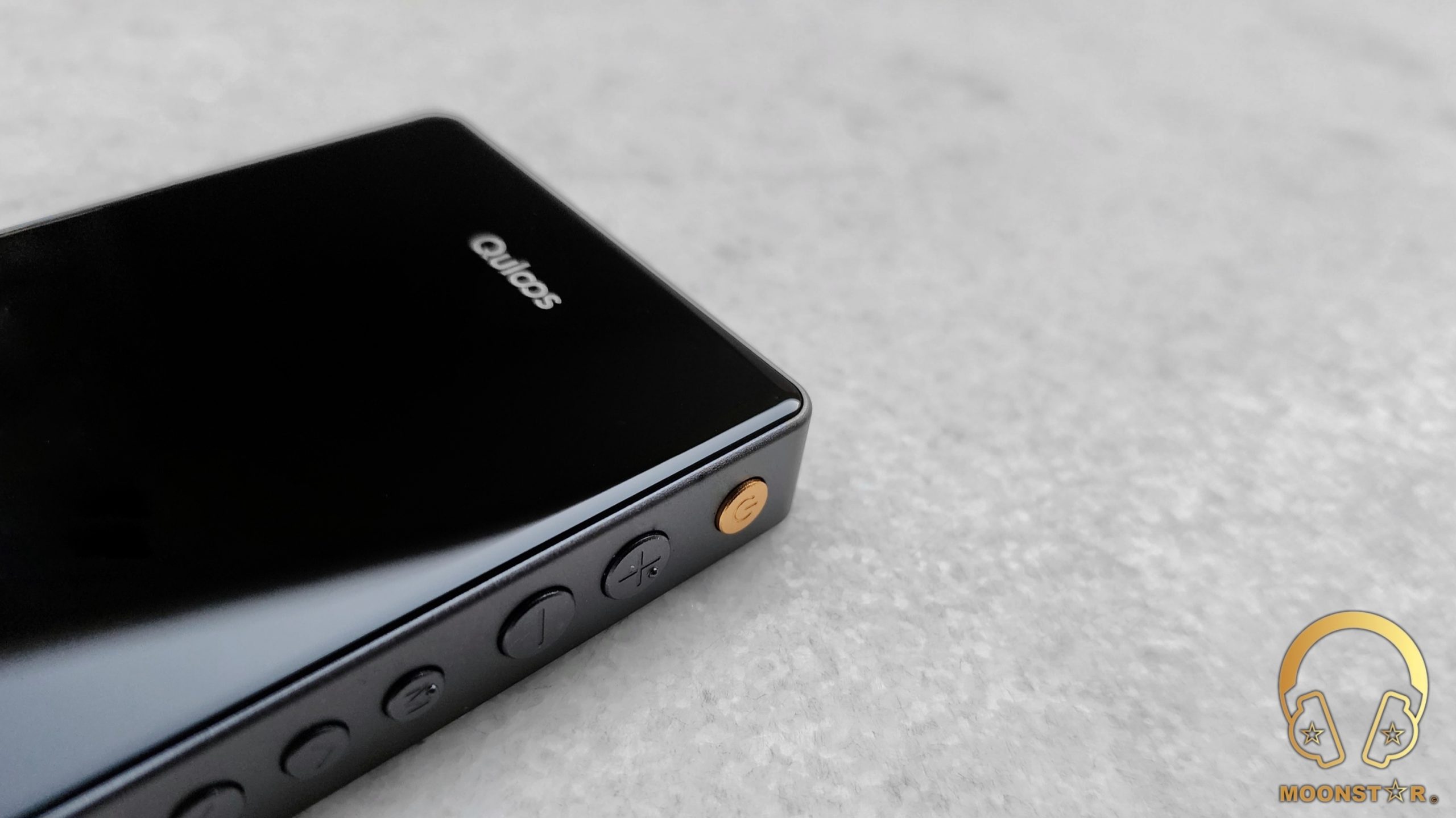
Disclaimer:
I would like to thank Quloos for providing me MUB1 Portable DAC/Amplifier for sample purposes. I am not affiliated with Quloos beyond this review and all these words reflect my true and unaltered opinions about the product.
Price & Availability:
The actual MSRP price of the Quloos QLS MC01 is 499.99 US$. More information can be found under the link below;
Package & Accessories:
The Quloos MUB1 came inside a rectangular black box with some brandings and a product illustration on the top.
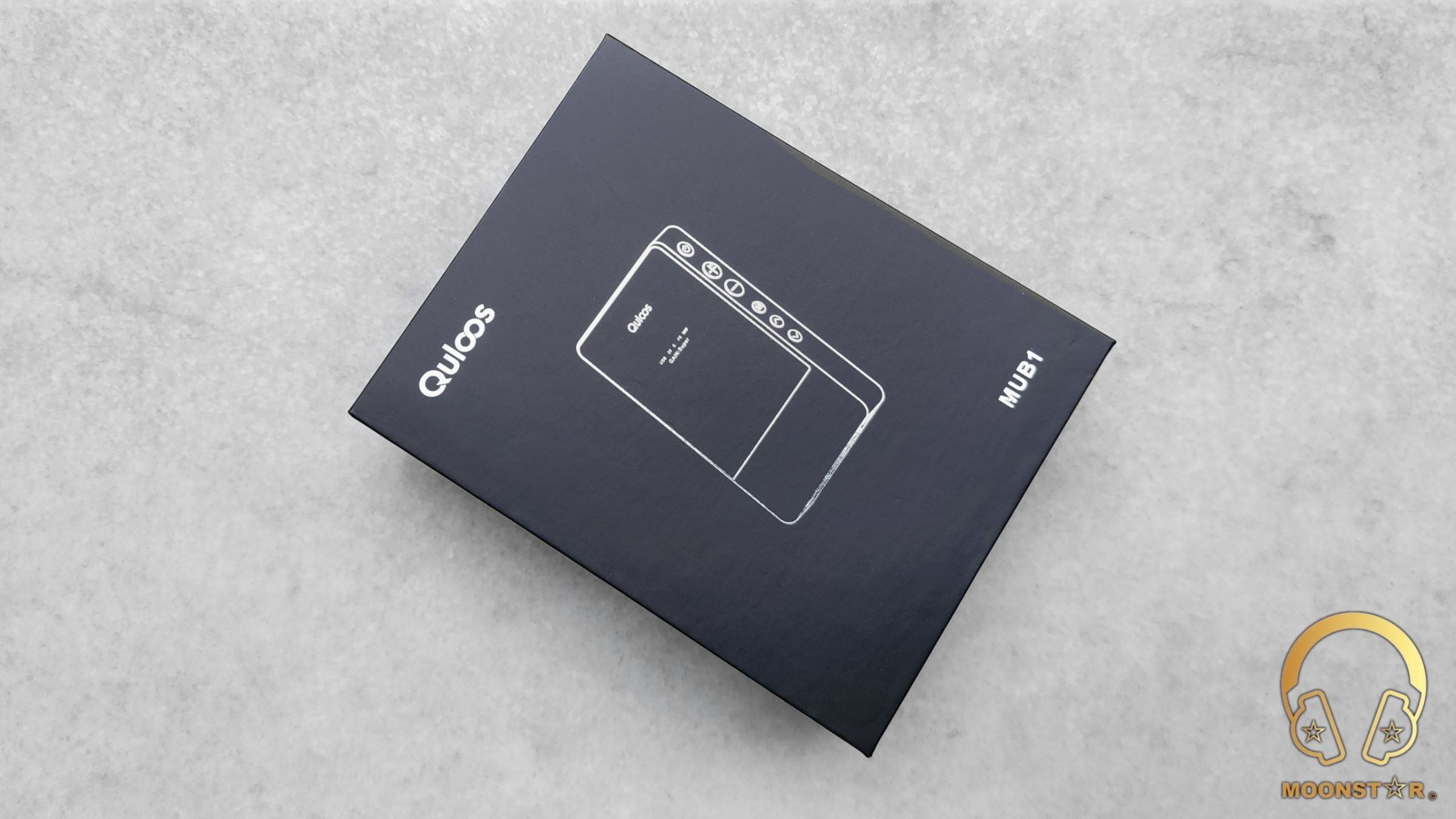
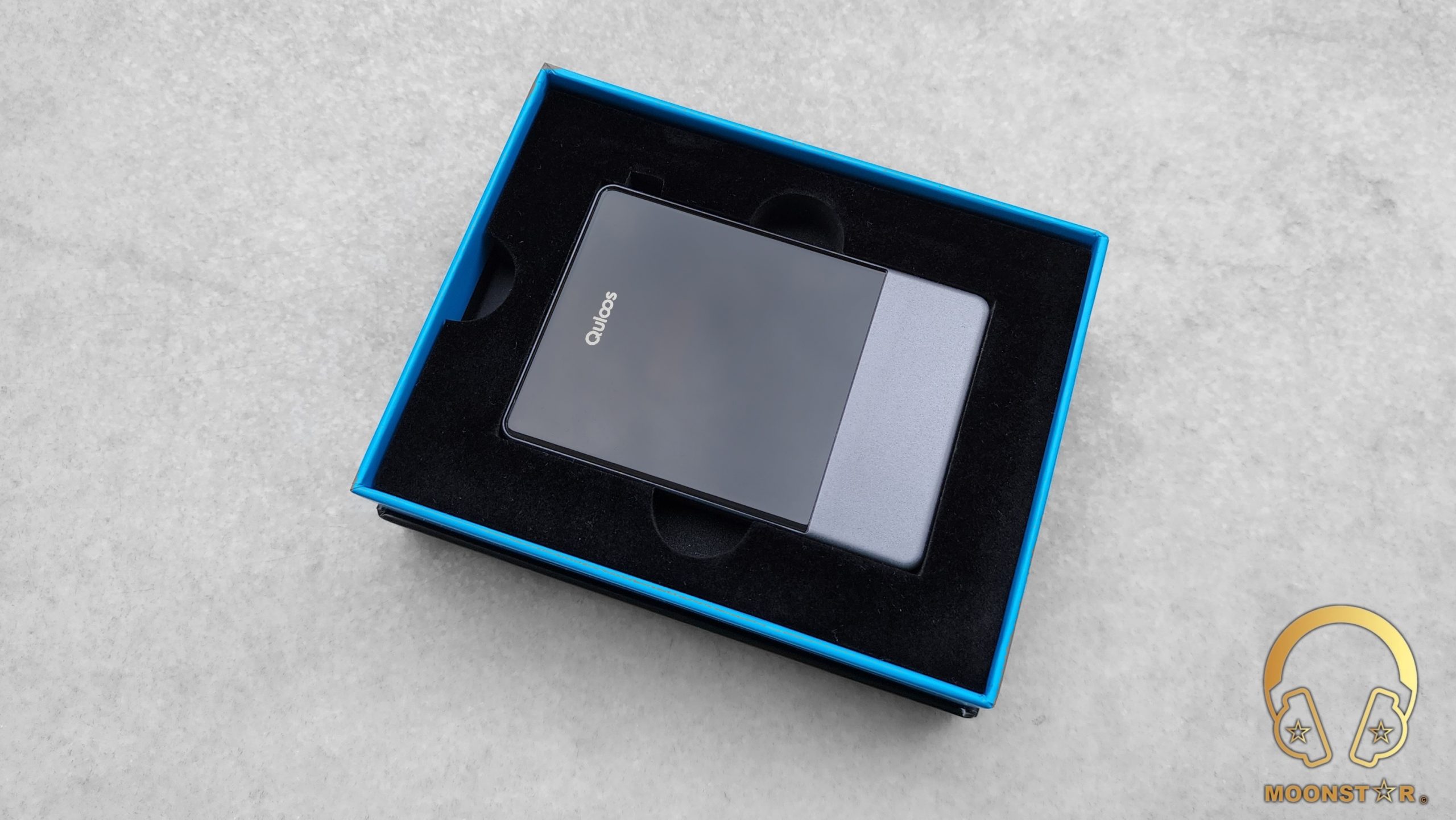
Inside the box of the MUB1 are the following contents:
- 1 x Quloos MUB1 USB DAC/Amplifier
- 1 x USB Type-C to Type-C Cable
- 1 x USB Type-C to Lightning Cable
- 1 x USB Type-C to USB A Adaptor
- 2 x PVC Screen Protector
- 1 x Silicone Case
- 1 X Print Material
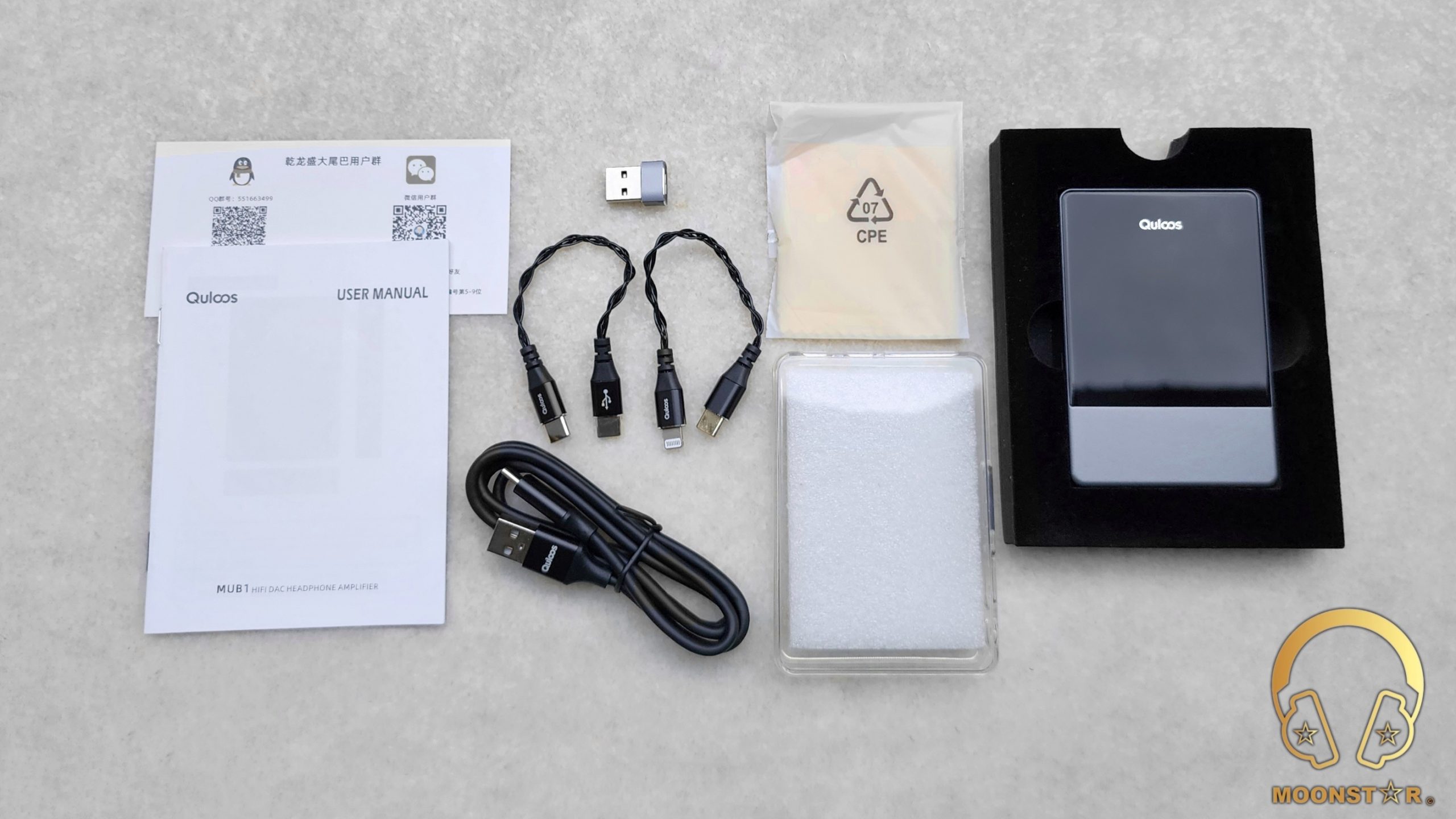
The Quloos MUB1 comes with both a USB Type-C to Type-C and USB Type-C to Lightning low profile cable that do have a nice braided design.
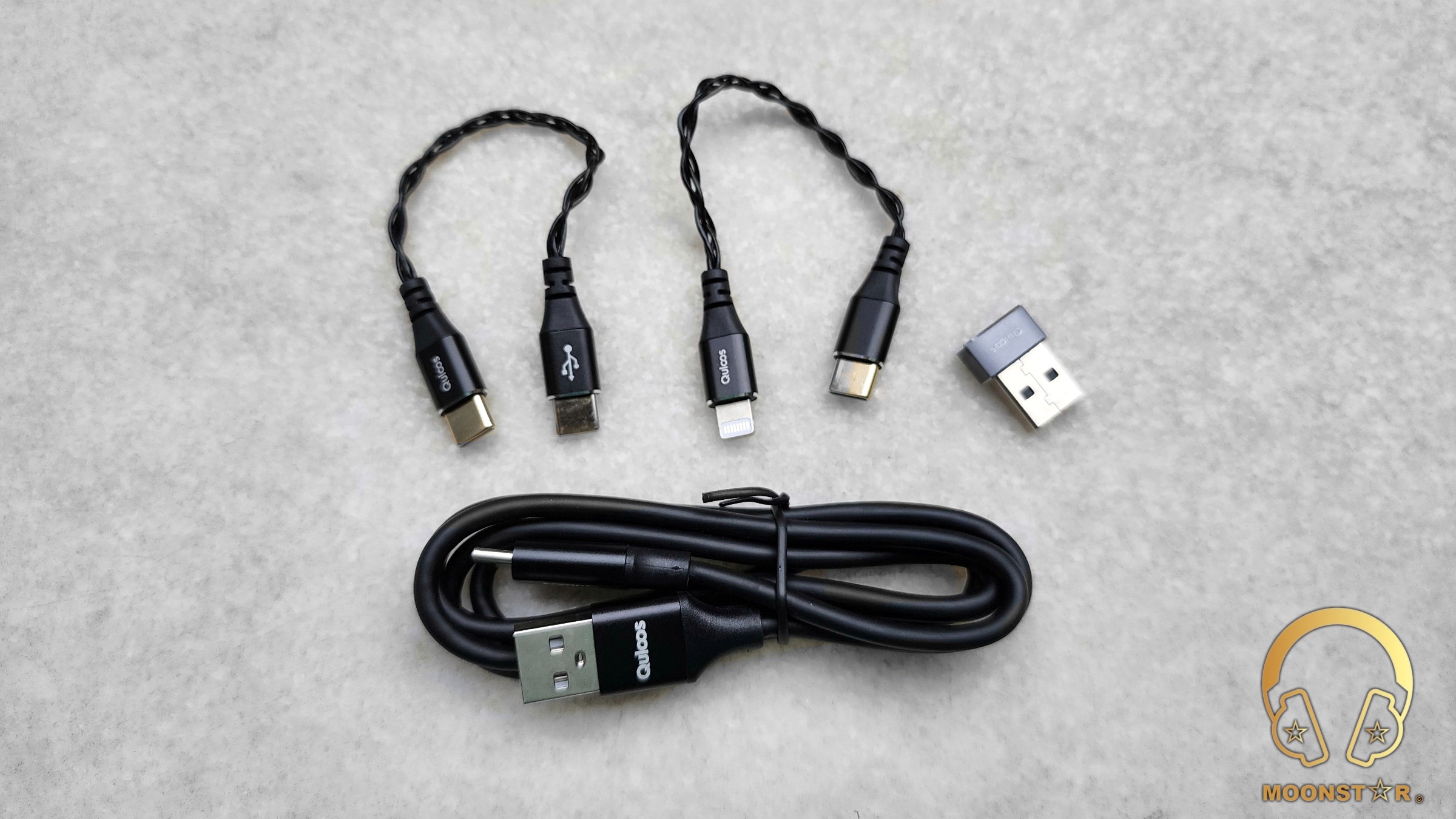
There is also a transparent silicone case that fits perfectly to the MUB1.
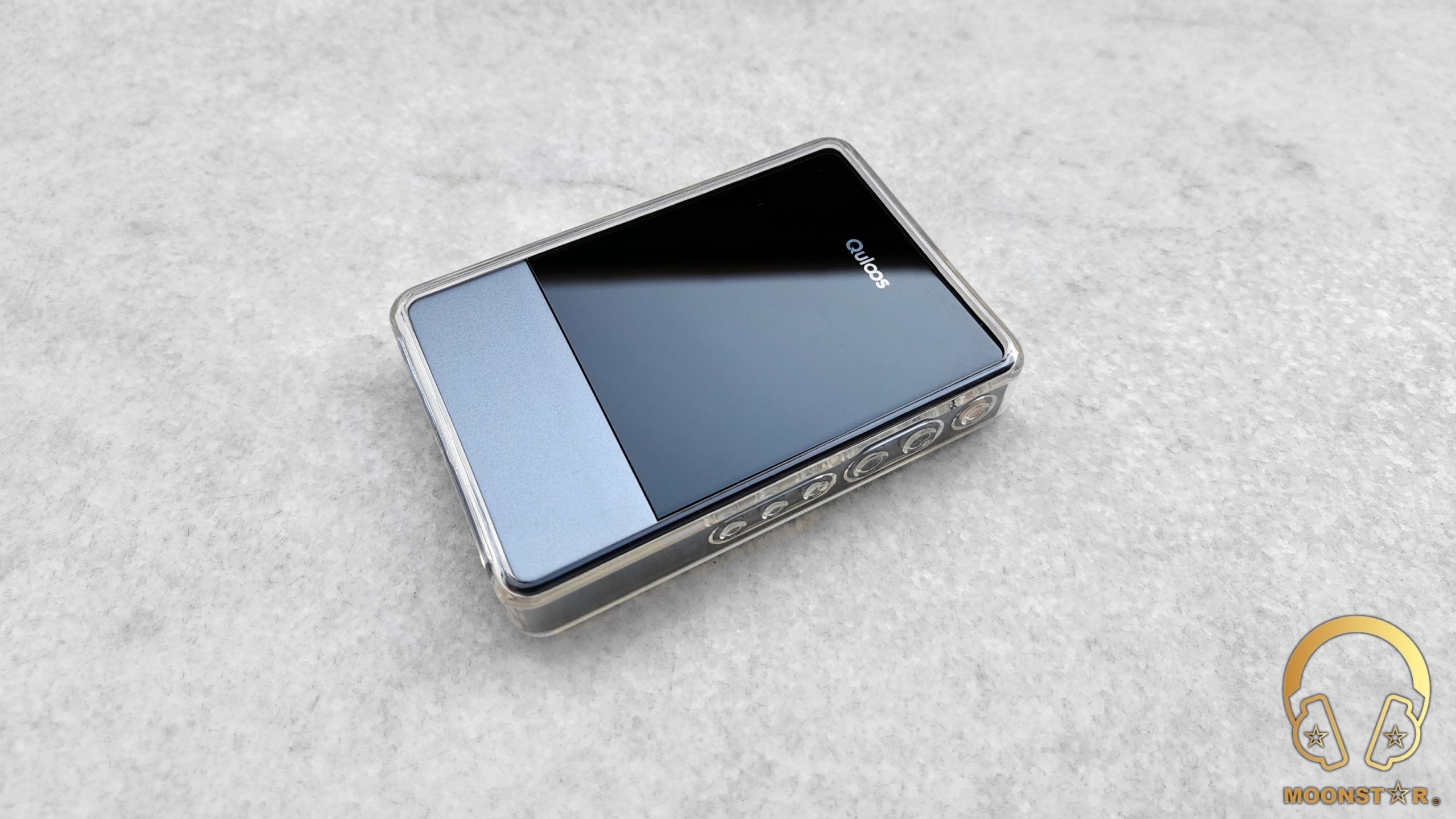
The leather case in the picture below is an optional item that can be purchased separately (Price: 30.00US$).
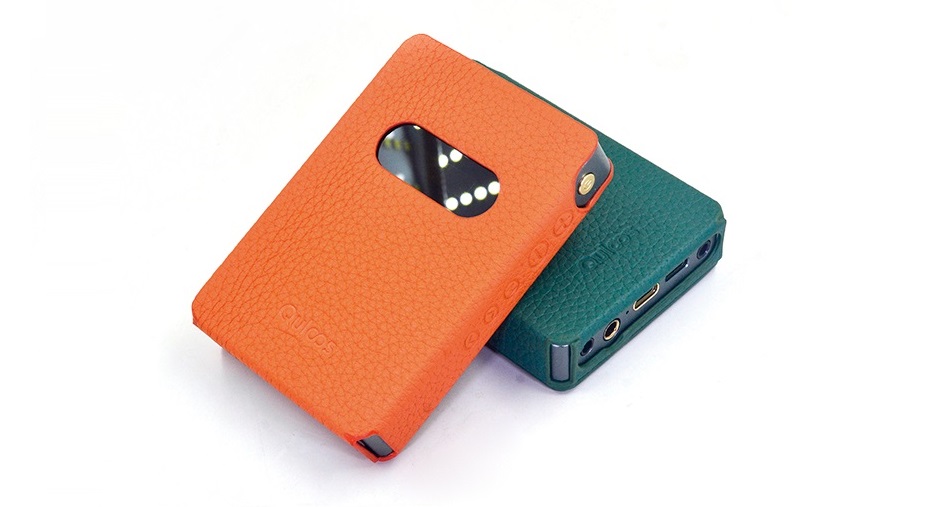
Design & Build Quality:
The Quloos MUB1 is an portable USB DAC/Amplifier with premium look & feel, and pretty pocket friendly from factor with respect of its high output power of up to 1100mW @ 32ohm (4.4mm Balanced output). The device has a 5-Axiss CNC machined aluminum alloy frame with glass panels on the front the rear side.
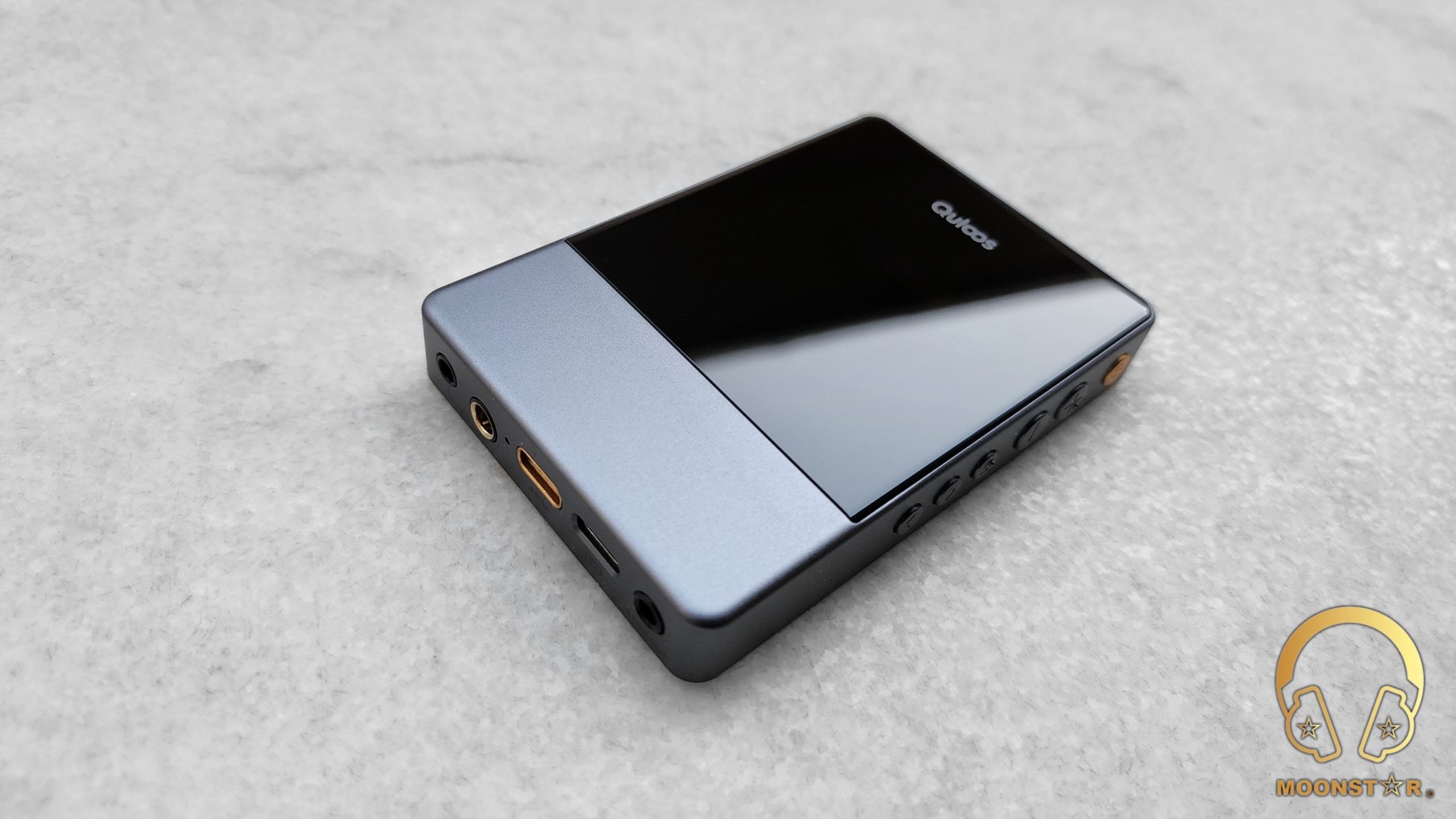
The dimension of the MUB1 is about 96*65*14.5mm (L* W * H) and it weights approx 142g (exclusive low profile cable).
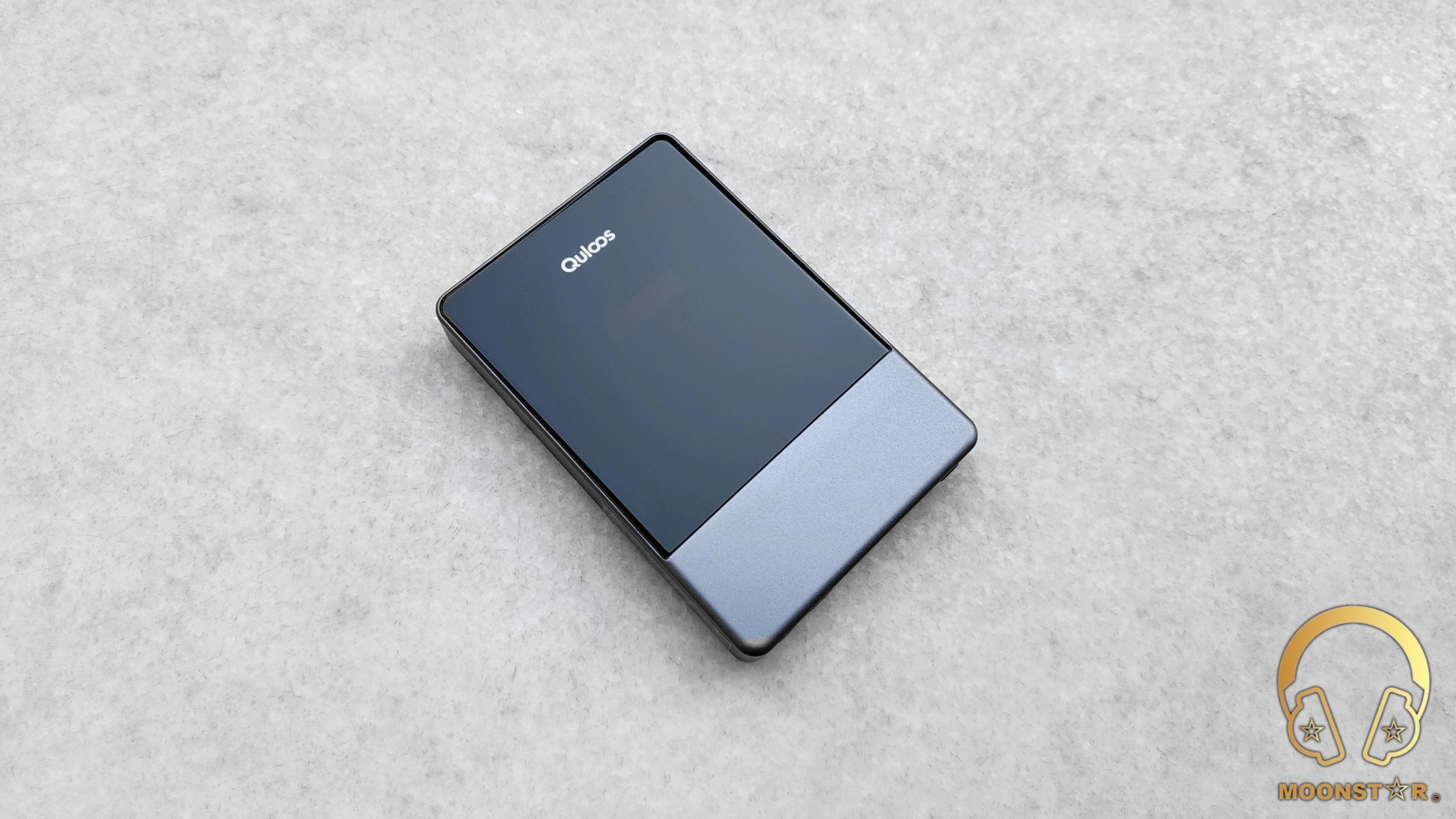
On the front of the device is a glass panel in black color where you can find a small OLED Display with adjustable screen brightens. It gives you quick information about the actual connection mode (USB/Bluetooth), volume, filter, battery and sampling rate of the device. The display gives you also direct access to multiple settings like output and input mode, filters, screen brightness, gain, etc. that you can navigate with the menu and navigation buttons located at the left side of the device surface.
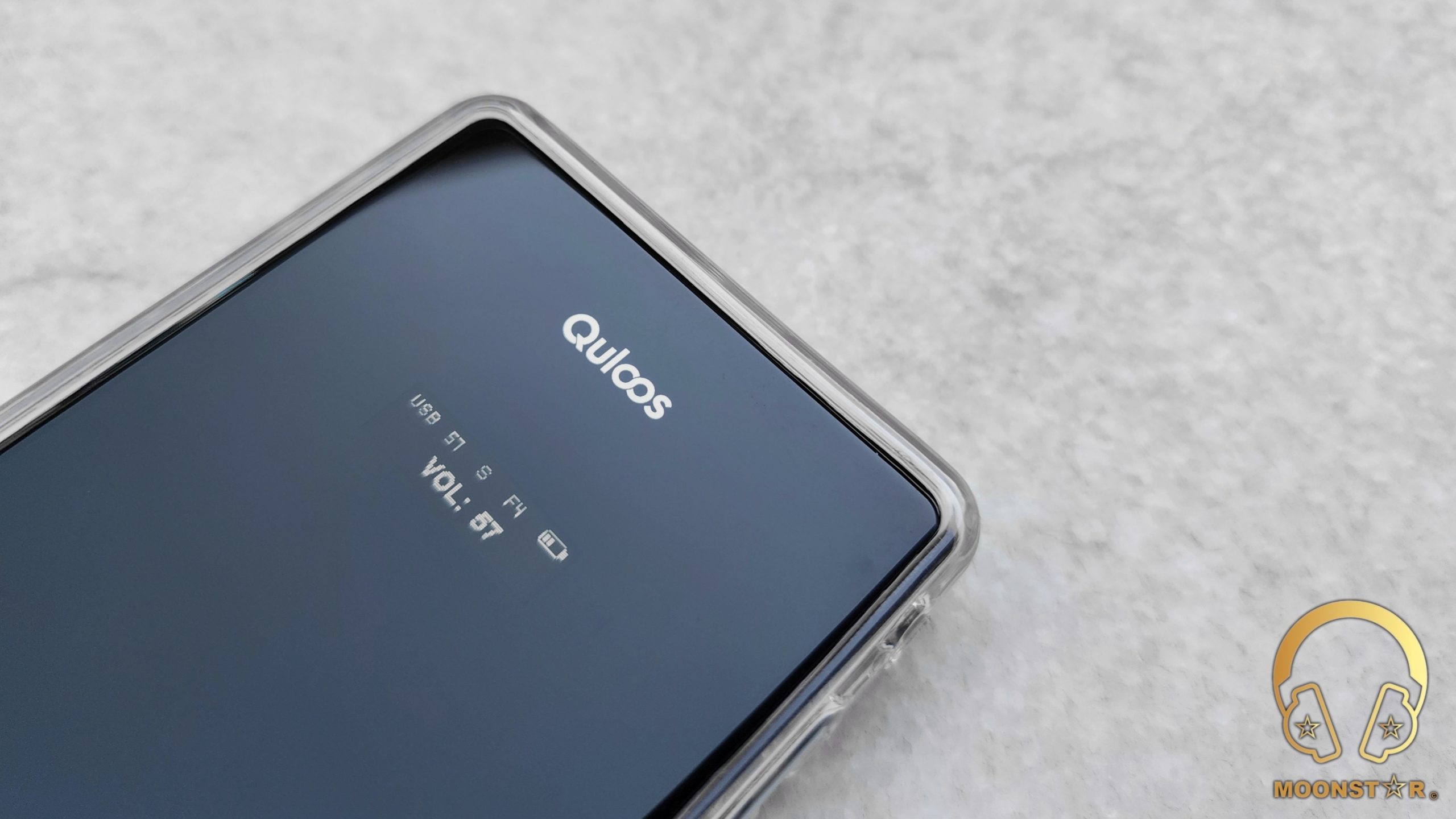
The right surface of the MUB1 is equipped with multiple hardware buttons which are the power button with a nice golden finish, the volume up / volume down, settings (M) and up & down navigation buttons.
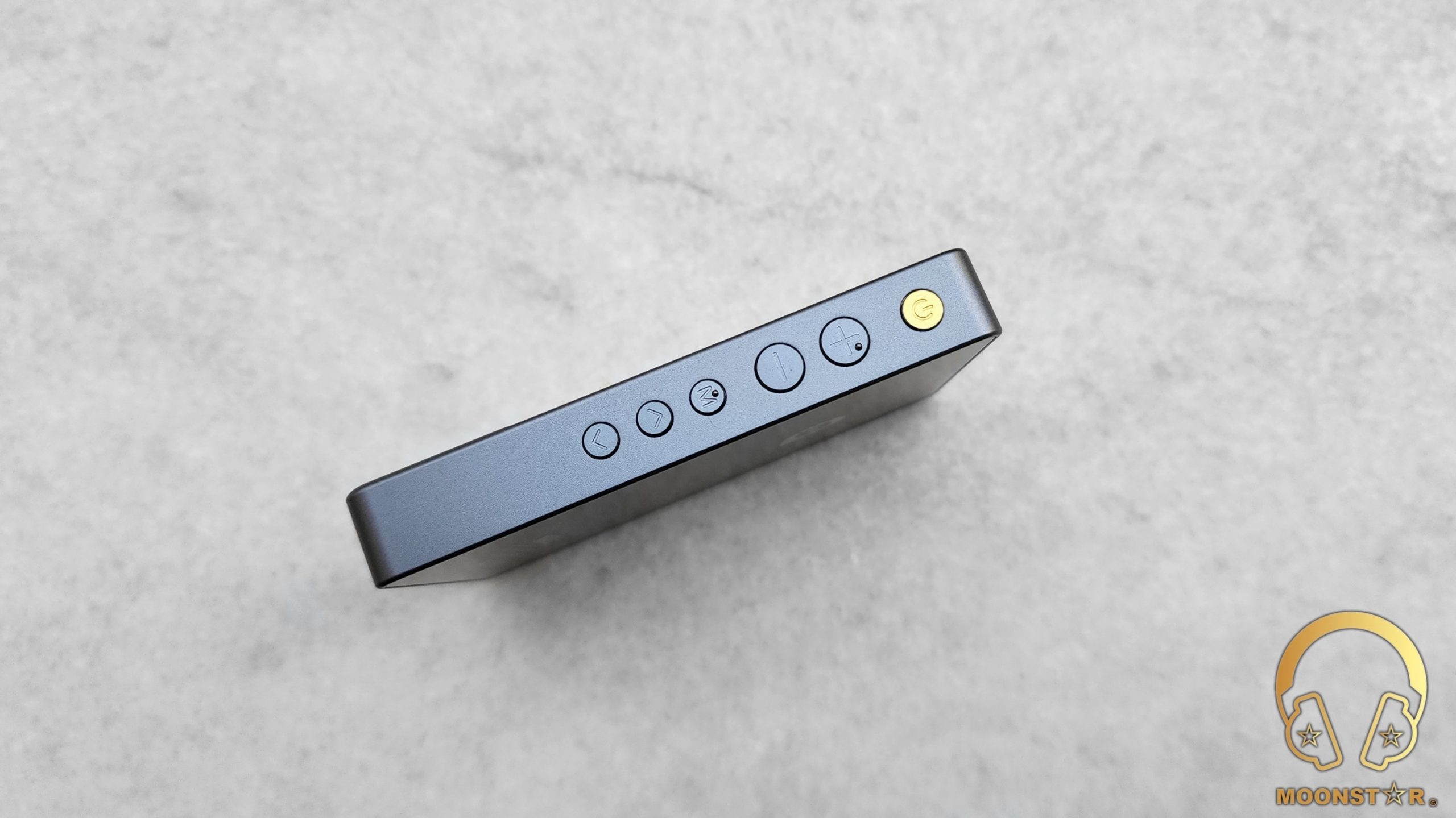
The up and down navigation buttons also serve as next and previous track interface.
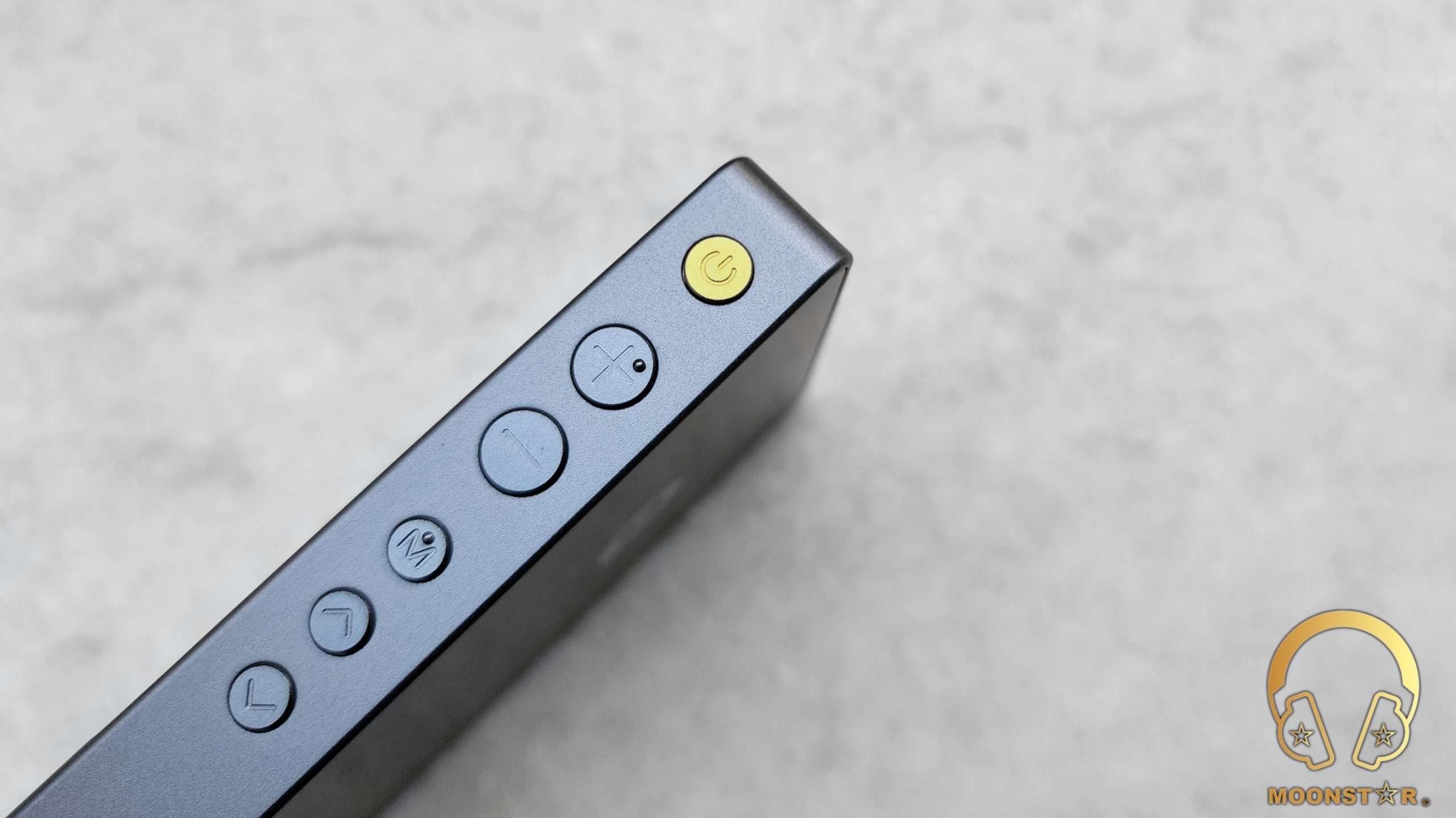
The bottom surface of the MUB1 features a very rich digital and analog connection interface.
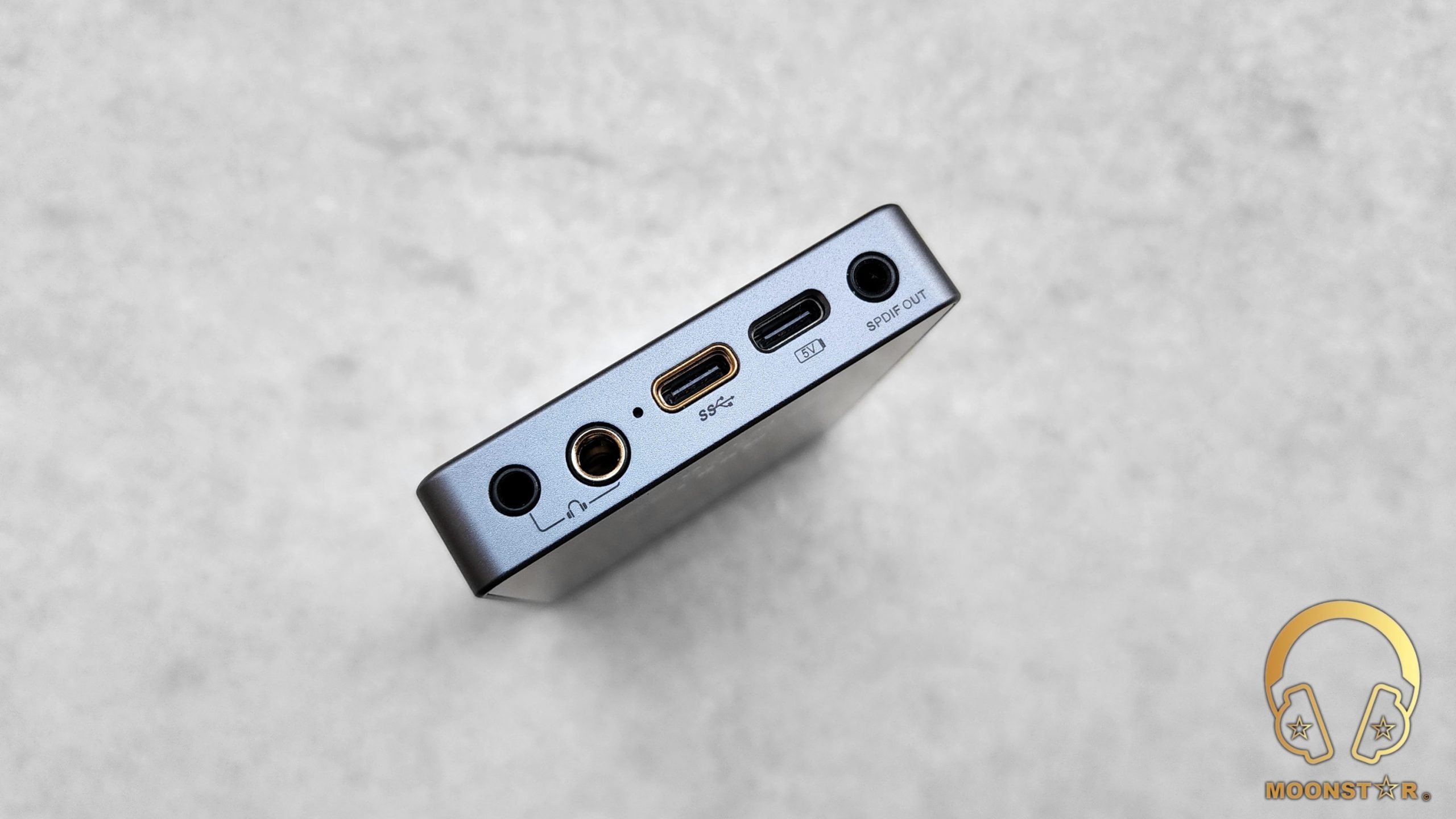
Here is a 3.5mm single ended headphone port that doubles as LO/AUX output port, a 4.4mm balanced headphone port that also works as a balanced LO port, a microphone pickup hole, the USB Type-C Audio & OTG input port, a USB Type-C charging port and a digital audio output port in form of a 3.5mm optical/3.5mm coaxial output interface.
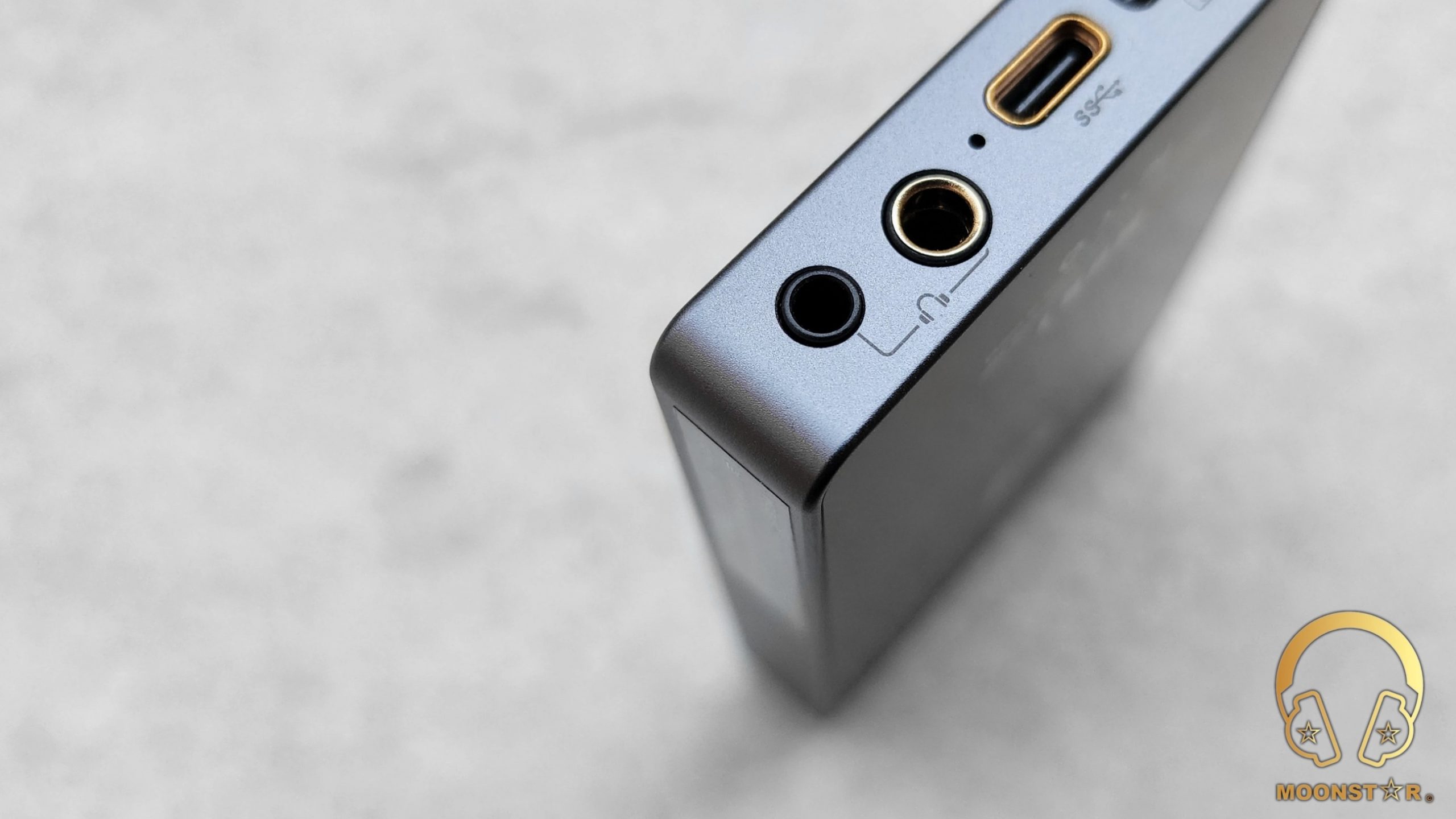
At the rear side of the device is the Quloos brand logo, some product related brandings (model, origin, etc.) and some industrial certifications.
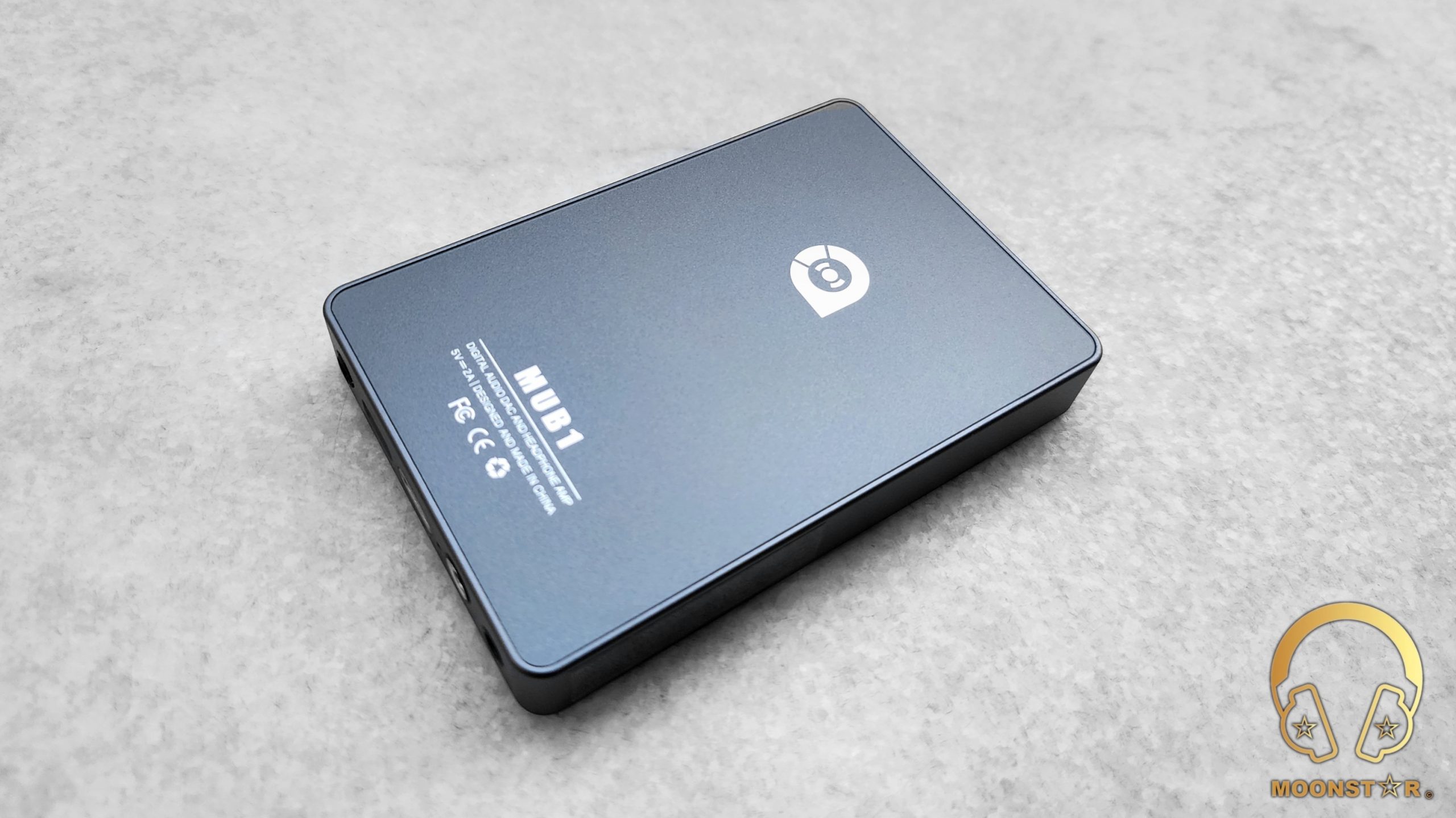
Right below you can find some key interface descriptions for the MUB1.
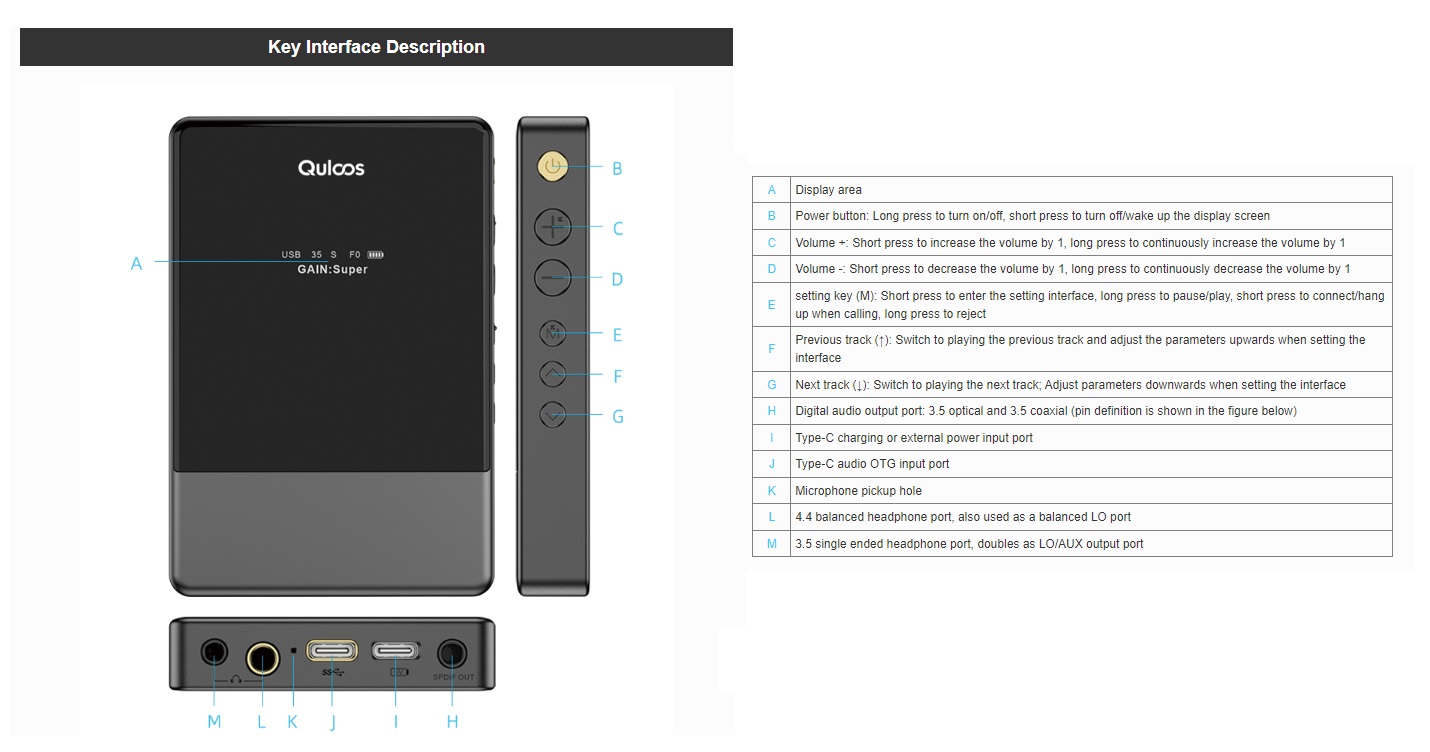
Quloos MUB1 Specifications:
| Item / model | Balance port | Single port |
| Body size | 96*65*14.5mm (L * W * H) | |
| Host weight | 142g | |
| Input interface | Type-C USB data, Type-C USB power supply&charging, wireless Bluetooth | |
| Bluetooth format | Bluetooth 5.0, LDAC, APTX, APTX-HD, ACC, SBC | |
| USB protocol | UAC2.0 protocol / UAC1.0 protocol, supporting Windows, Mac, Android, iOS systems | |
| USB port DSD sampling rate | 2.8224MHz (DSD64), 5.6448MHz (DSD128), 11.2896MHz (DSD256), Native or DoP | |
| USB port PCM sampling rate | 16Bit ~ 32Bit, 44.1kHz ~ 384kHz | |
| Output interface | 3.5 single ended & 4.4 balanced headphones (can be set to Line out/Aux out), 3.5 optical or coaxial SPDIF digital output | |
| Optical/ coaxial output | 16Bit ~ 24Bit, 44.1kHz ~ 192kHz PCM, DoP64 | |
| DAC chip | CS43131 * 4 pieces, QFN large package | |
| OP | Selected 2 OP* pieces with excellent texture and musical appeal | |
| Headphone amplifier chip | BUF634A * 4 | |
| Gain control | Low / Mid / High / Super-High | |
| Volume control | This device has a volume level of 100, which can be independently adjusted from the phone volume | |
| Frequency response | 20Hz ~ 20kHz ±0.5db | |
| THD+N (AES17 (20kHz), A-weighted, unloaded, medium gain) | 0.0001% | 0.00015% |
| SINAD (AES17 (20kHz), unweighted, unloaded, medium gain) | 120db | 116db |
| SNR (A-weighted, medium gain) | 132db | 126db |
| Dynamic range (A-weighted, medium gain) | 132db | 124db |
| Crosstalk (unloaded, medium gain) | -140db | -137db |
| Crosstalk (32Ω, medium gain) | -95db | -73db |
| Output power (THD+N<0.01%, S-gain) | 1100mW + 1100mW @32Ω | 410mW + 410mW @32Ω |
| 250mW + 250mW @300Ω | 65mW + 65mW @300Ω | |
| Noise floor (A-weighted) | 1.2uVrms @G = L | 1.8uVrms @G = L |
| 1.2uVrms @G = M | 1.8uVrms @G = M | |
| 2.5uVrms @G = H | 2.5uVrms @G = H | |
| 8.3uVrms @G = S | 5.8uVrms @G = S | |
| Reference: High sensitivity headphones are also difficult to hear to the noise floor. When QA361 has low gain, the noise floor is 4uV. | ||
| Battery life | 8~10 hours | |
| Charging time | 2~3 hours | |
| Charger | Type-C charger (user provided), DC 5V, ≥2A | |
| External power input | Input from charging port Type-C, DC 5V, ≥2A | |
| Microphone function | Support Bluetooth calls with built-in omnidirectional microphone |
Hardware Features:
The MUB1 is an ultra compact USB & Bluetooth DAC/Amplifier that features some impressive hardware specs. The device is equipped with four high-performance 32-Bit DAC chips featuring four units of CS43131 decoding chips and four BUF634 amp chips to achieve balanced headphone amp architecture, with an output power of up to 1110mW @32Ohms. The MUB1 comes with both 3.5mm SE and 4.4mm Balanced and a separate 3.5mm Optical/SPDIF Digital outputs interface.
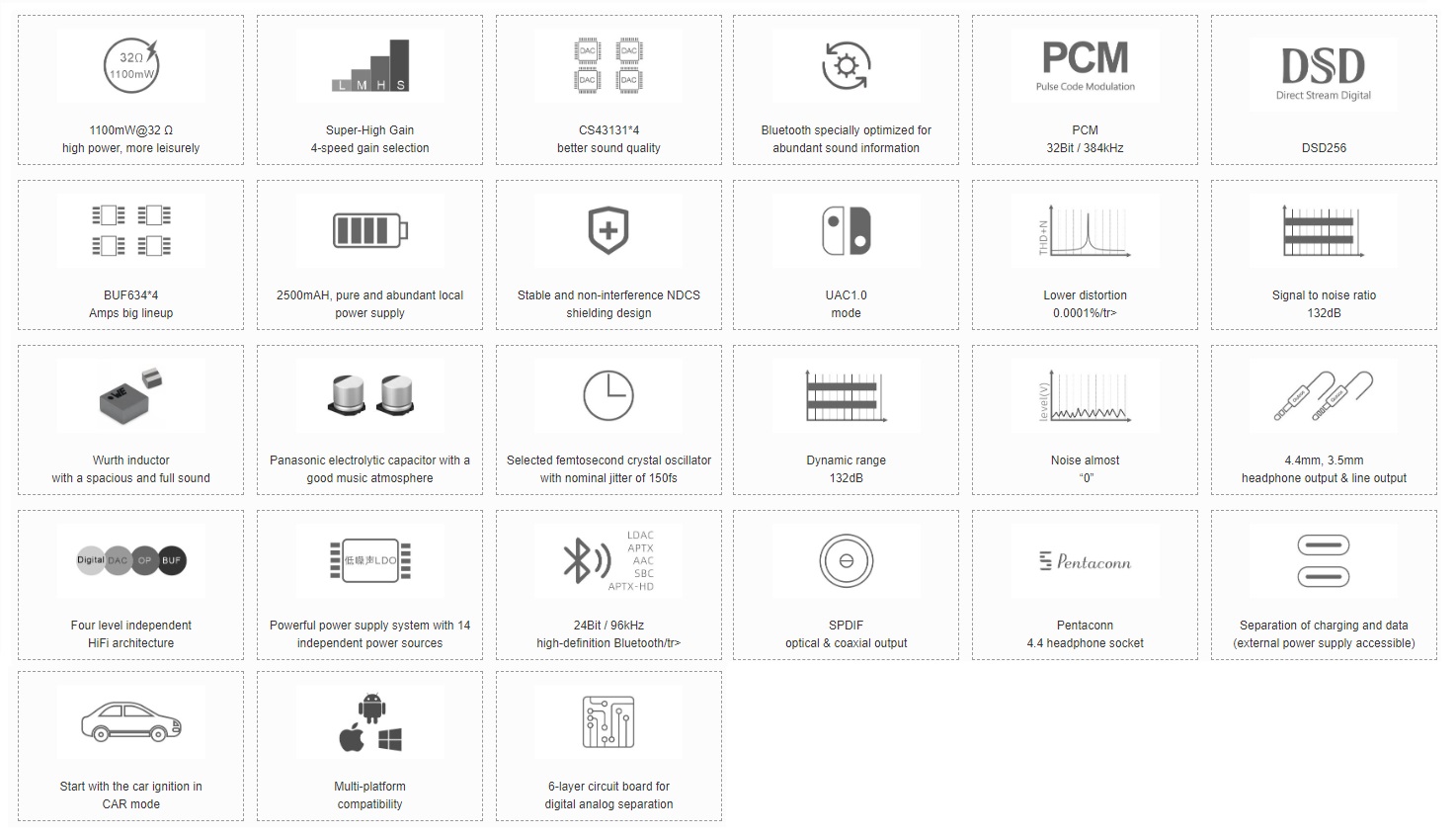
Dual Cirrus Logic CS43131 DAC & Supported Sampling Rates
The Quloos MUB1 is equipped with four high-performance 32-Bit DAC chips featuring four units of CS43131 decoding chips. This 32-Bit Quad-DAC arrangement is able to archive excellent values such like a SNR (Signal to Noise Ratio) of 132dB and THD+N (Total Harmonic Distortion) of just 0.00001% over its 4.4mm Balanced headphone output, which is quite impressive for such a compact portable all-in one solution.The Quad CS43131 inside the MUB1 has the capability to decode Hi-Res audio signals up to 32-Bit/384kHz PCM and Native DSD256.
| DSD Decoding | 2.8224MHz (DSD64), 5.6448MHz (DSD128), 11.2896MHz (DSD256), Native or DoP |
| PCM Decoding | 16 / 24 / 32Bit, 44.1kHz, 48kHz, 88.2kHz, 96kHz, 176.4kHz, 192kHz, 352.8kHz, 384kHz |
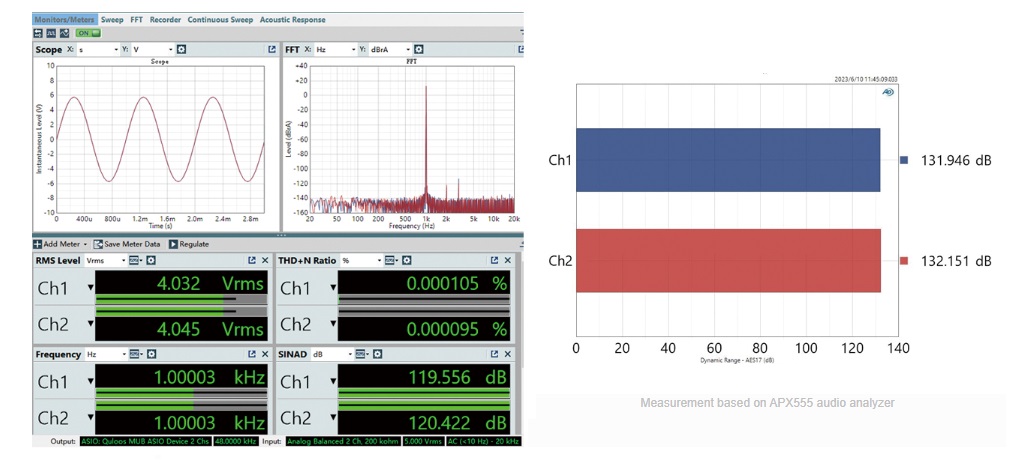
Balanced Circuit & Amplification:
The Quloos MUB1 has a pretty innovative and sophisticated balanced audio circuit design that is equipped with carefully selected audio components such like High-Power Amplification Chips, Panasonic Film Capacitors, Würth inductors, etc. All this components have been integrated in to a 6-layer circuit board for digital analog separation.
Quloos MUB1 comes with both a 3.5mm Single-Ended and 4.4mm Balanced headphone ports with dual output ability. The device is equipped with a specially developed high-power headphone amp section designed with 4x units of BUF634 amp chips, which offers an impressive power output of up to 1100mW @ 32ohm (in Super-High Gain) that was capable properly to drive fairly demanding planar headphones like the HiFiMAN Edition XS and Moondrop PARA.
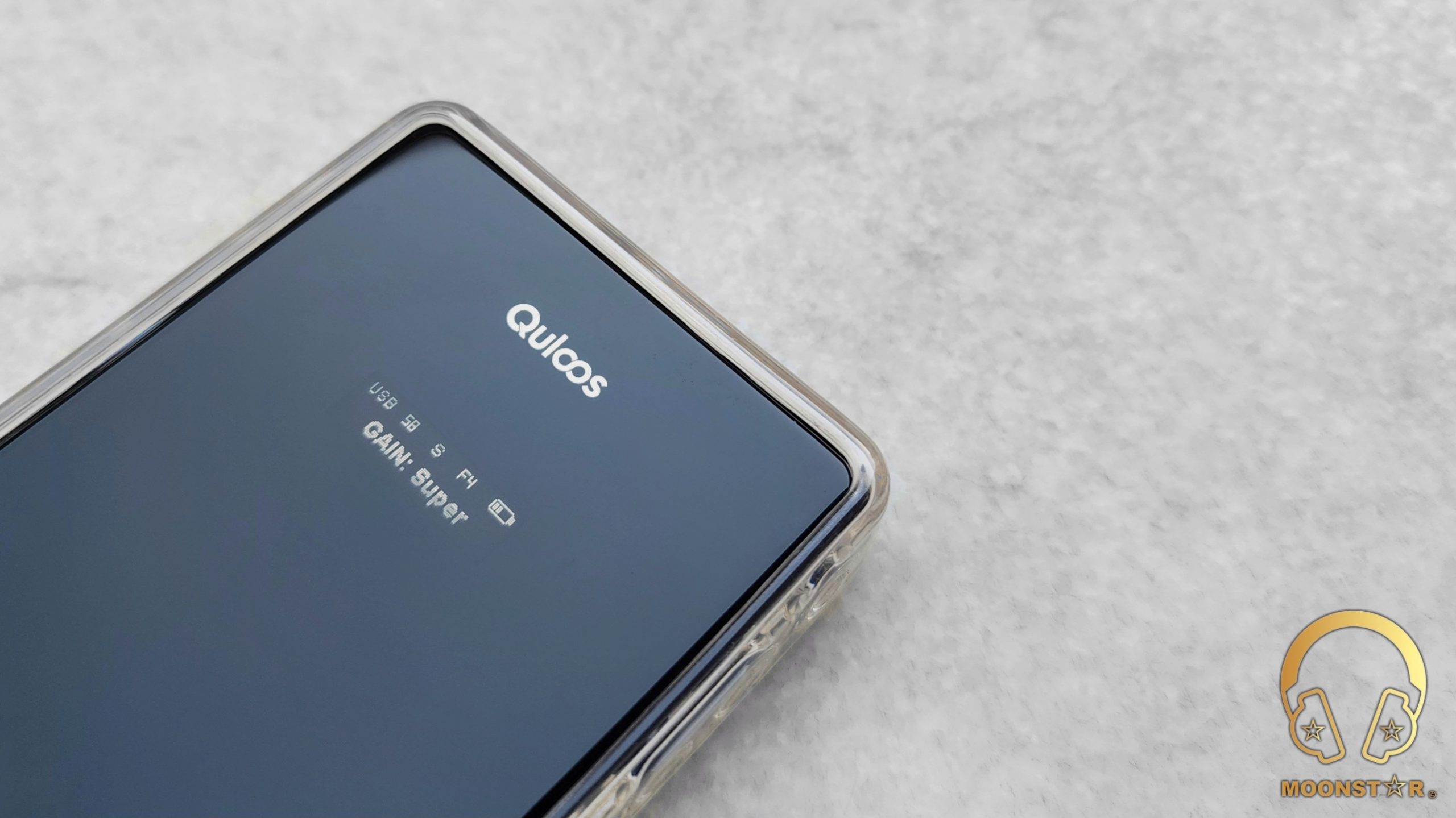
The MUB1 offers 4 Gain modes that are Low, Medium, High and Super-High. Low and Medium are ideal for sensitive IEM, while High and Super-High are suitable for harder to driver earphones and headphones. Very remarkable is the very clean, noise free and almost pitch black background of both the 3.5mm SE and 4.4mm Balanced outputs.
It is also remarkable to mention that the MUB1 didn’t heat up despite it is powerful device with a small size and built-in battery, which makes it comfortable to use in your pocket, even after longer listening periods.
Another feature of the MUB1 is the high-precision “Femtosecond Crystal Oscillators” with only 150fs of nominal jitter.

Compatibility:
The Quloos MUB1 supports multiplatform including Android Smartphone’s/Tablets, iOS devices such like iPhone’s & IPad’s, Computers installed with Mac or Windows and even a Nintendo Switch. Quloos MUB1 works on both USB modes, the UAC 2.0 which is a standard today for most devices, and UAC 1.0 mode commonly used in previous-generation systems or low-power output devices such as Nintendo Switch, etc.
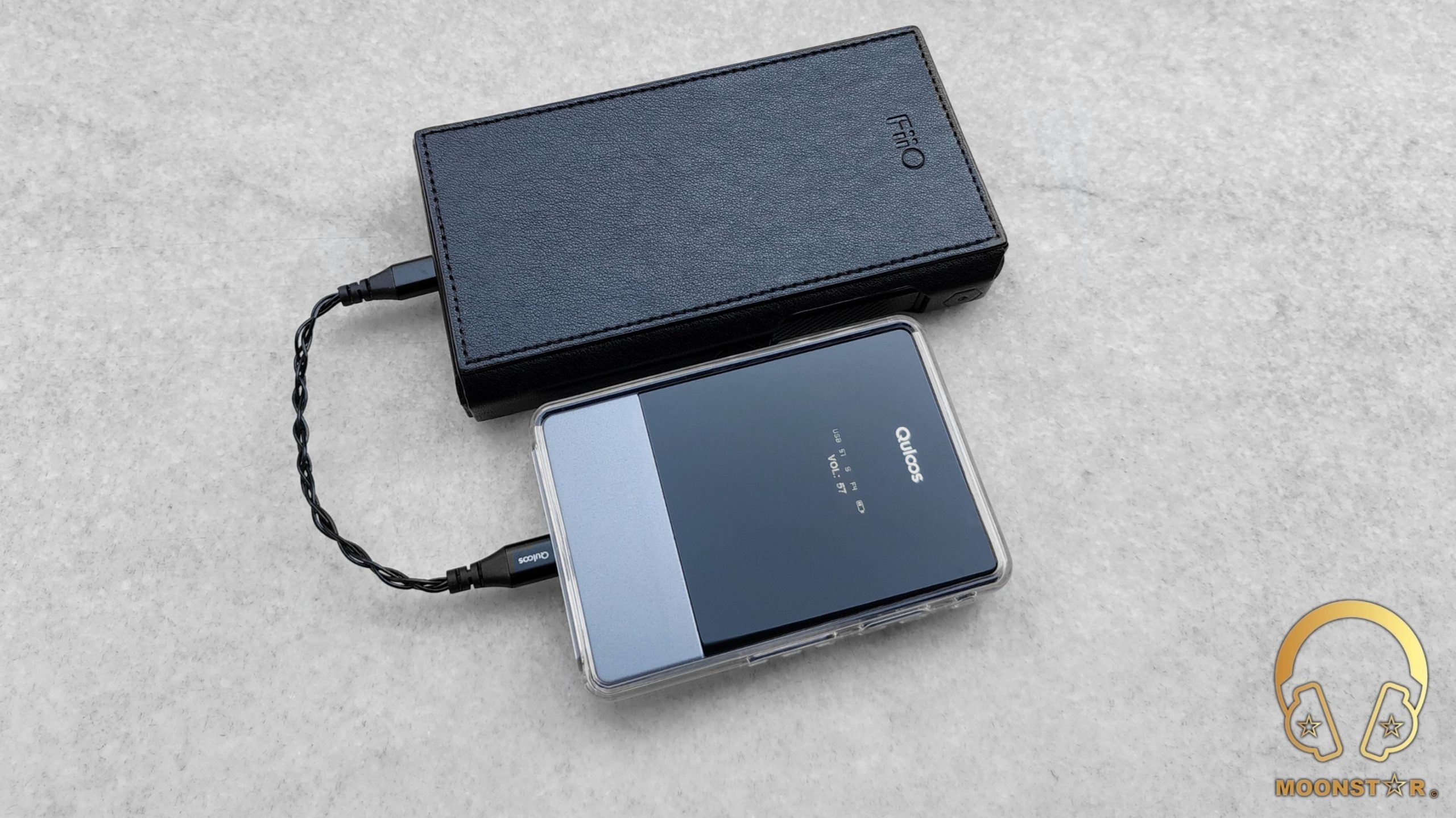
Bluetooth Connectivity:
The Quloos MUB1 can be used as a wireless DAC/Amplifier since it is equipped with a Bluetooth chip and Antenna that supports the V5.0 BT protocol. The MUB1 supports most of the advanced high-resolution wireless codec’s including LDAC, AptX HD, AptX and more traditional formats like AAC and SBC. The sound performance of the MUB1 when connected as a Bluetooth DAC/AMP is pretty decent!
The Quloos MUB1 also has a strong Bluetooth connection that can reach up to approx 10 meters without any problems. The device works well with videos and movies on YouTube, Netflix, Disney+, Amazon Prime, etc., and does not have any noticeable lip-sync delays when I paired it with my Samsung Galaxy TAB S8 Ultra and Samsung Galaxy S22 Ultra. This is because it supports LDAC and AptX-HD codec’s.
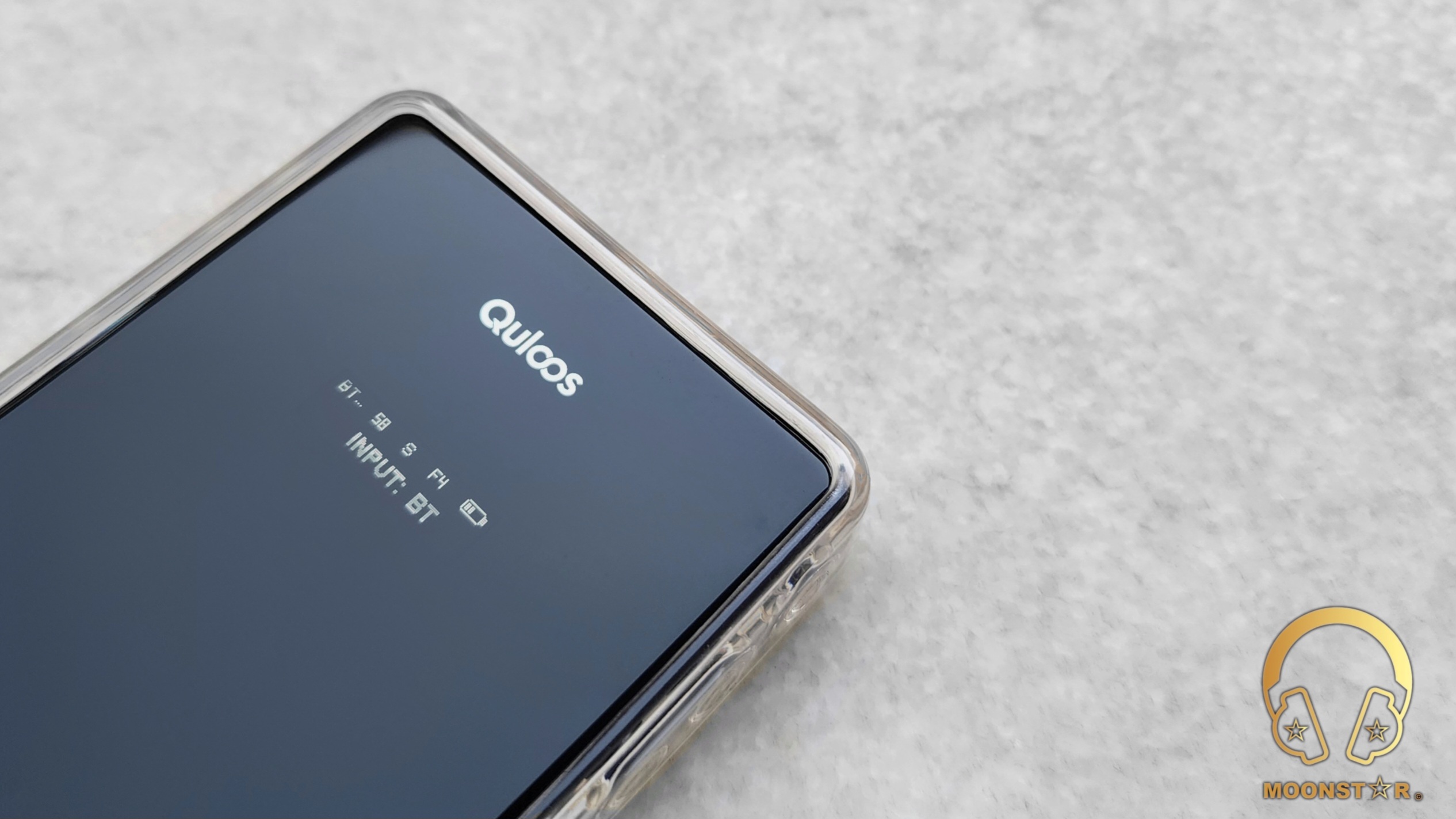
Battery Life & Power Bank Function:
The Quloos MUB1 has a big battery of 2500mAh that can last for 10 hours. This is an above average performance for such a small and powerful device. The MUB1 also has a special feature: it has two USB Type-C ports; one port is for the digital input, and the other port is for charging. You can use this port to charge the MUB1 or you can use it as a power bank to charge your device that is connected to the MUB1.
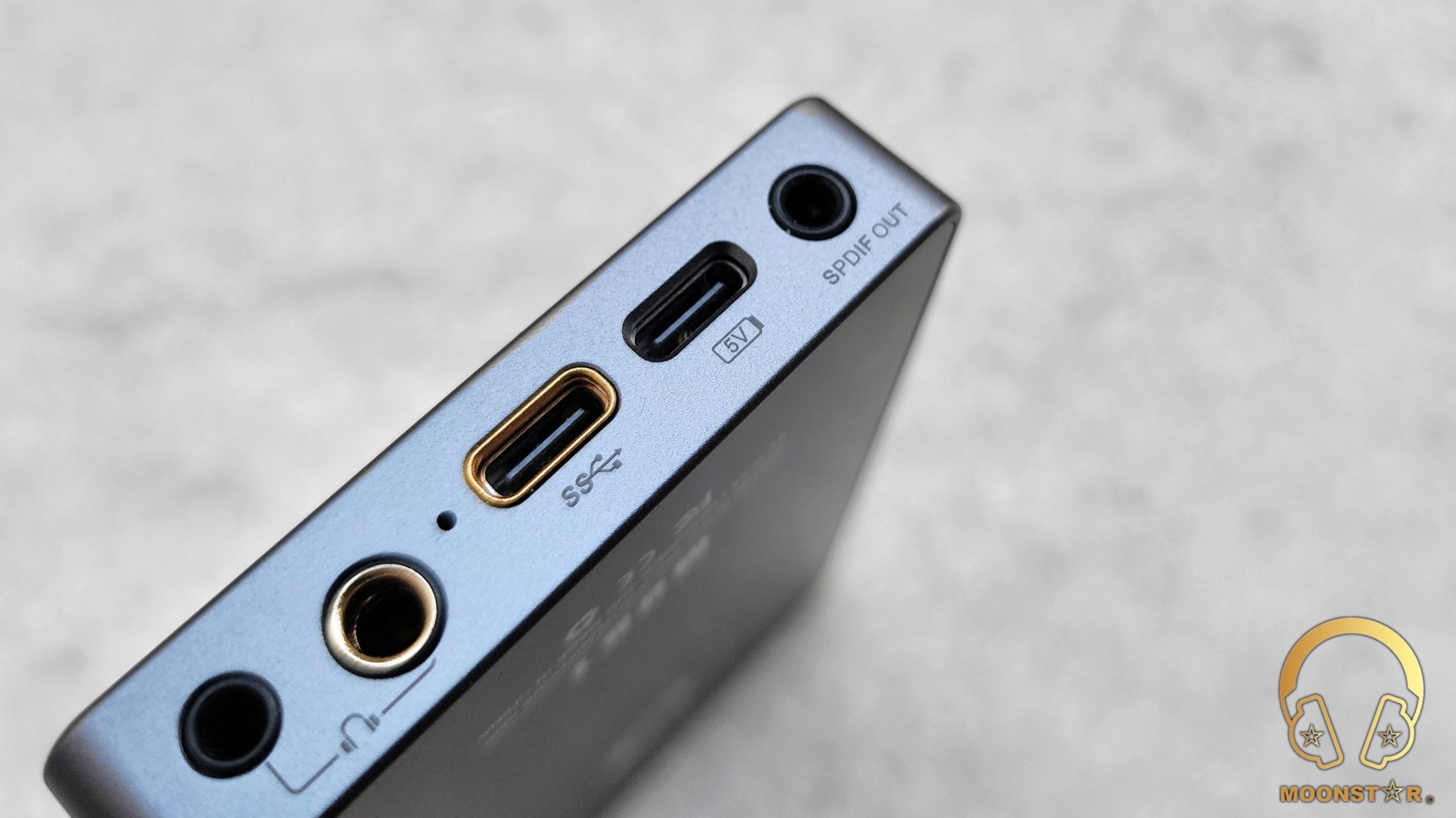
Battery Test Results:
- 5mm Single Ended Output: approx 9.5 – 10 Hours @ High Gain
- 4mm Balanced Output: approx 7.5 – 8 Hours @ High Gain
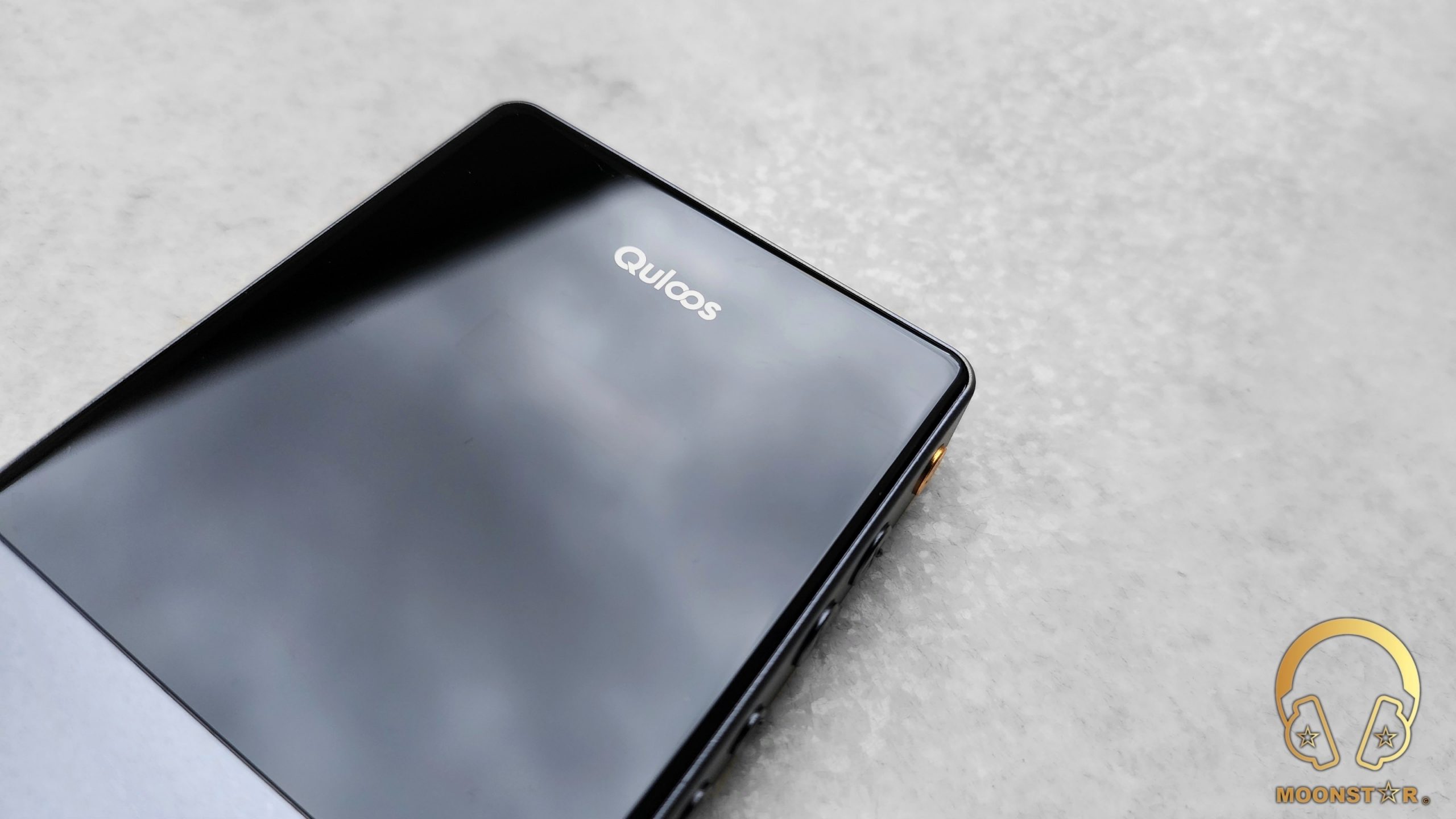
Equipment’s used for this review:
- DAC/AMP’s : Quloos MUB1
- Sources : Samsung Galaxy S22 Ultra, Samsung Tab S8 Ultra, ASUS TUF FX505DU
- IEM’s : Campfire Audio Solaris Horizon, Westone MACH60, Moondrop Blessing 3
- Headphones : HiFiMAN Edition XS, Moondrop PARA
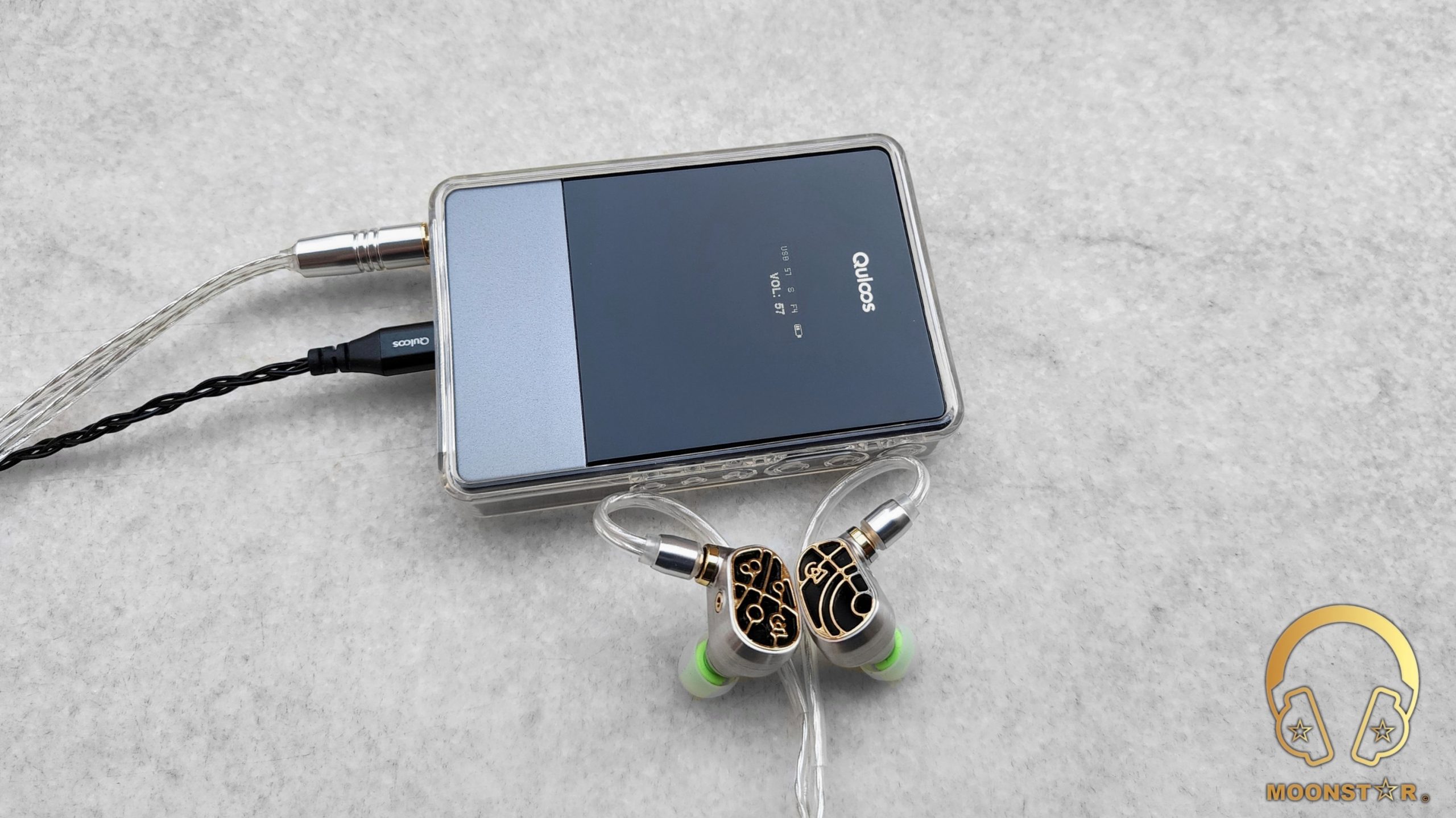
Albums & tracks used for this review:
- Adele – My Little Love (Spotify)
- Randy Crawford – On Day I Will Fly Away (Flac 16bit/44.1kHz)
- Hayley Westenra – Odyssey Album (Dezzer HiFi)
- Dionne Warwick – Walk On By (Flac 16bit/44.1kHz)
- Sarah McLachlan – Angel (Flac 24bit/48kHz)
- Sertap Erener – Aşk (Flac 16bit/44.1kHz)
- Edith Piaf – Non Je Ne Regrette Rien (Flac 16bit/44.1kHz)
- Diana Krall – So Wonderful (DSF)
- Aretha Franklin – I Say A Little Payer (Flac 24bit/96kHz)
- Sonya Yoncheva – (Giuseppe Verdi) II Trovatore, ActI (Flac 24bit/96kHz)
- George Michael – Don’t Let the Sun Go Down on Me (Flac 24bit/192kHz)
- David Bowie – Heroes (Flac 24bit/192kHz)
- Elton John – Rocket Man ((Flac 24bit/96kHz)
- Barry White – Just The Way You Are (Flac 24bit/48kHz)
- Isaac Hayes – Walk On By (Flac 16bit/44.1kHz)
- Sting – Englishman in New York – (Flac 24bit/48kHz)
- Eric Clapton – Wonderful Tonight (Flac 24bit/96kHz)
- B.B. King – Riding With The King (Tidal Hi-Fi)
- Dave Gahan – Kingdom (Tidal Hi-Fi)
- U2 – Sunday Bloody Sunday (Flac 16bit/44.1kHz)
- Bro Safari, UFO! – Drama (Deezer HiFi)
- Armin Van Buuren – Vini Vici (Flac 16bit/44.1kHz)
- Daft Punk – Doin’ it Right (Flac 24bit/96kHz)
- Christian Reindl – Freya (Deezer HiFi)
- Lorde – Royals (Flac 24bit/48kHz)
- Massive Attack – Angel (Flac 24bit/48kHz)
- Toutant – Rebirth (Deezer HiFi)
- Gogo Penguin – Raven (Flac 24bit/192kHz)
- Gogo Penguin – Murmuration (Flac 24bit/192kHz)
- Portishead – It Could Be Sweet (Spotify)
- Max Richter – On the Nature of Daylight (Flac 24bit/96kHz)
- Charly Antolini – Knock Out 2000 Album (Deezer HiFi)
- Ferit Odman – Look, Stop & Listen (Flac 24bit/192kHz)
- Chopin – Nocturn No. 20 In C-Sharp Minor (Flac 16bit/44.1kHz)
- Fazıl Say – Nazım Oratoryosu (Live) (Flac 16bit/44.1kHz)
- Vivaldi – Le QuarttroStagioni “The Four Season” (Deezer HiFi)
- Otto Liebert & Luna Negra – The River (Flac 24bit/192kHz)
- Lunatic Soul – The Passage (Flac 16bit/44.1kHz)
- Deftones – My Own Summer (Shove it) (Flac 16bit/44.1kHz)
- Metallica – Sad but True (Flac 24bit/96kHz)
- Metallica – Master of Puppets (Flac 24bit/96kHz)
- Opeth – Windowpane (Flac 16bit/44.1kHz)
- Megadeth – Sweating Bullets (Tidal Hi-Fi)
- Rush’s – Leave That Thing Alone (Flac 16bit/44.1kHz)
- Slayer – Angel of Death (Spotify)
- Liquid Tension Experiment 2 – Acid Rain (Spotify)
- Yosi Horikawa – Bubbles (Spotify)
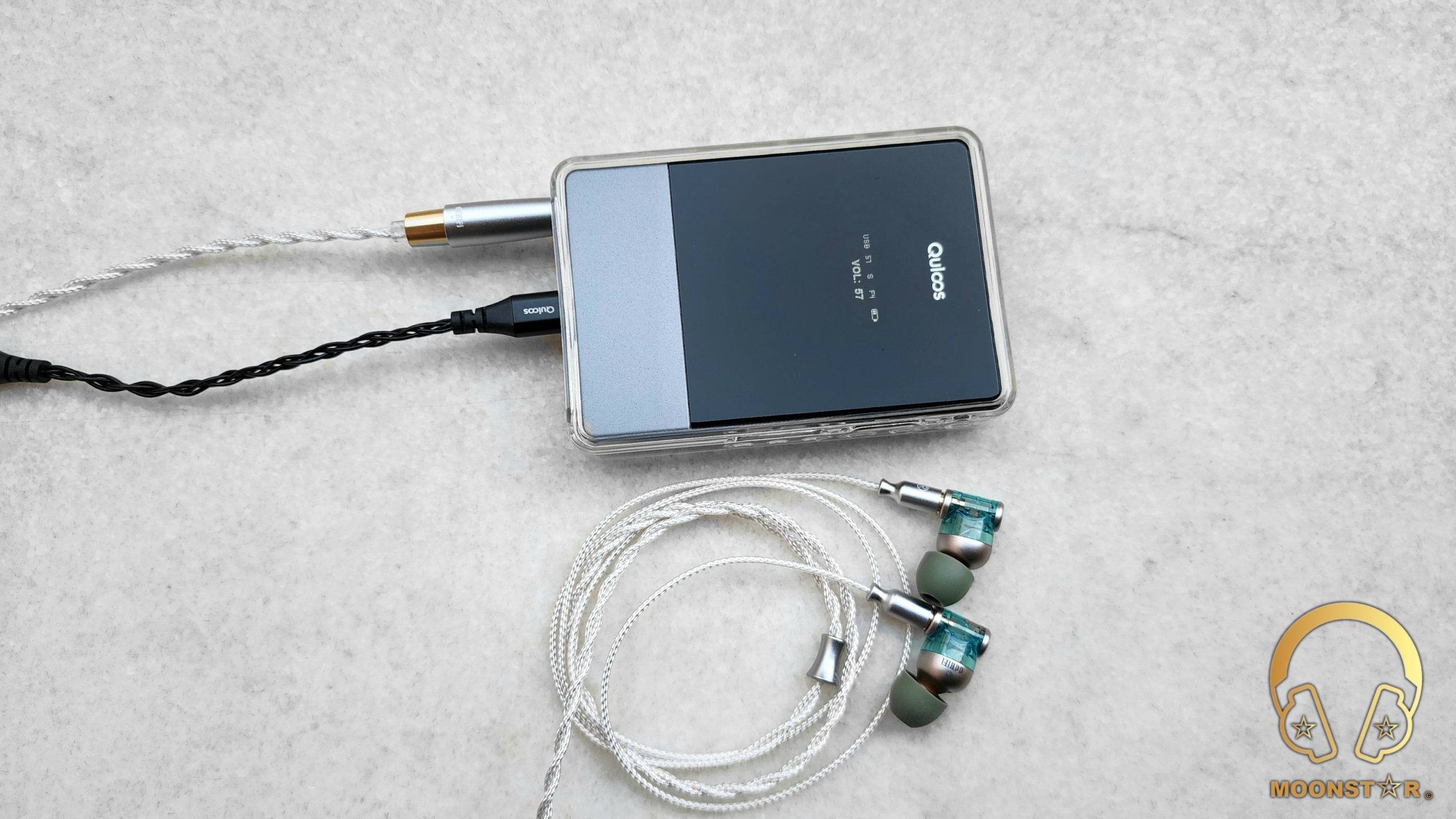
The Sound:
The Quloos MUB1 is a quite powerful portable DAC/Amplifier with small size and compact design, which offers an impressive overall sound performance that was beyond my expectation. The device can handle different genres of music with ease and delivers a balanced and natural sound signature with the IEM’s and Headphones I have tested the device. The MUB1 stands out with its very good tonal balance!
The bass can be described as deep, powerful and well-controlled, giving most music genres a solid foundation and impact. The midrange impressed me with its rich, smooth and pretty detailed character, bringing out the vocals and instruments with accuracy and emotion. The treble range on the other hand is natural and crisp, able to create a good sense of airy and extension, and adding clarity to the music without being harsh or sibilant. The soundstage is presented in a pretty natural and spacious manner that shows a good sense of depth and wideness, especially when you use it in Super-High Gain mode.
I know that this seems quite promising, but the sound & output performance of this pretty small and compact device is simply stunning. It doesn’t give you the feel that you listen to a portable device; it has a unique presentation that is very close to a desktop device. But keep in mind that the MUB1 requires some burn-in to show its best since it is equipped with some electronic compounds that do benefit from these.
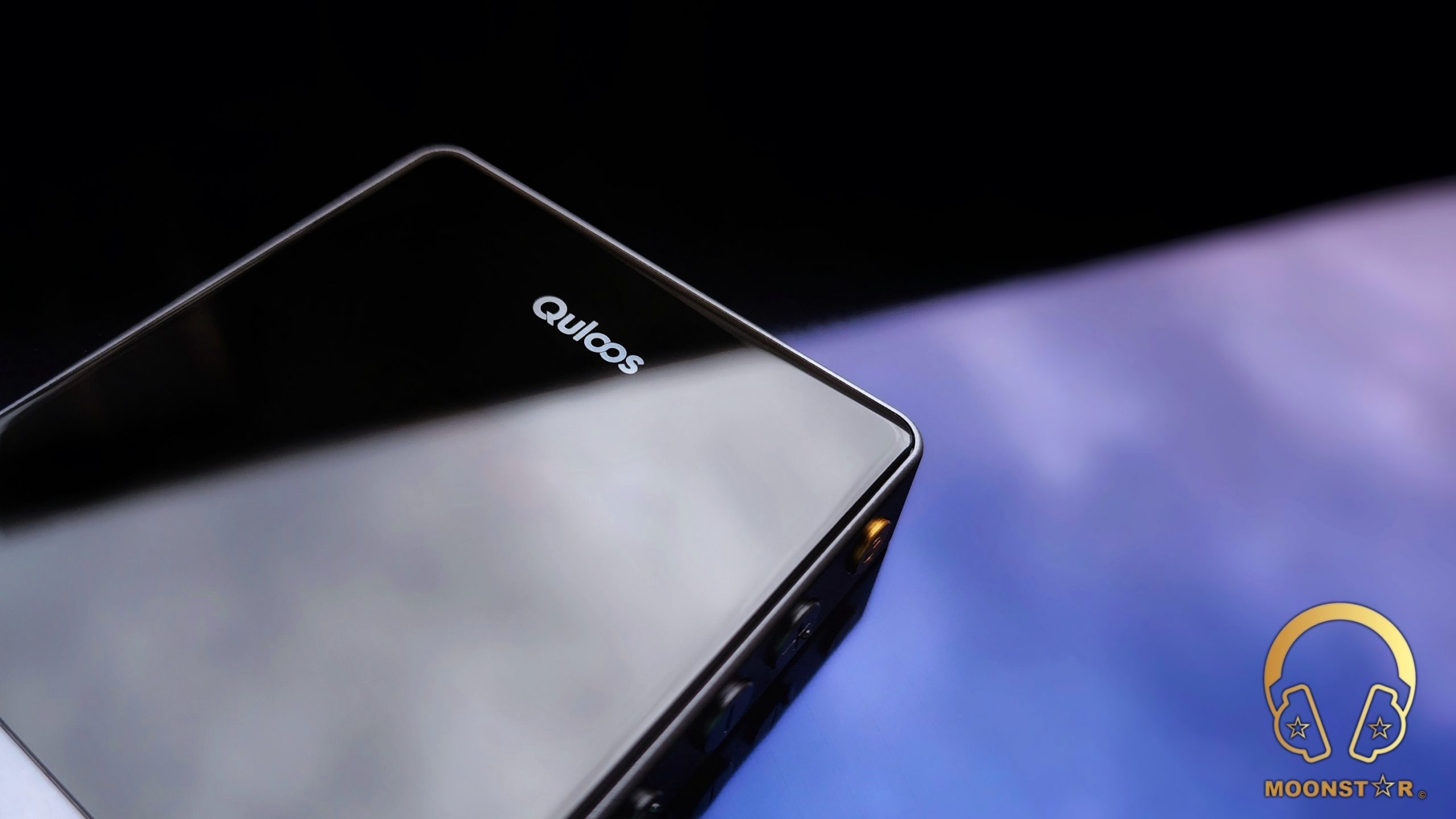
Sound Performance in Bluetooth Mode:
Another surprise for me was the sound performance when I have connected the MUB1 to a Bluetooth source like a Smartphone (Galaxy S22 Ultra) or tablet (Tab S8 Ultra) via LDAC codec. The sound what I do hear is relative close to the to the USB DAC mode. Yes, you will lose some sense of dynamics and some grade of micro details here and there, but what you get it is a pretty impressive type of sonic quality which you most likely won’t reach with other Bluetooth devices, and I’ve tested tons of them.
The Quloos MUB1 review has been written after a burn-in period of approx 120 hours. My sound impressions bellow are based on my experiences with IEM’s like the Campfire Audio Solaris Stellar Horizon, Westone MACH60, Moondrop Blessing 3 and Headphones like the Moondrop PARA and HiFiMAN Editions XS. The device has been used with the stock “NOS (None-Over Sampling)” Digital Filter and at “High Gain” with IEM’s and Super High Gain with Headphones.
Bass:
The Quloos MUB1 impressed me with its pretty natural and rich bass response with top notch level of layering. The subbass region has a natural feeling of depth and rumble when I listen to songs like Christian Reindl’s “Freya”, Massive Attack’s “Angel” or Lorde’s “Royals”, paired with IEM’s like the Campfire Audio Solaris Horizon and Westone MACH 60. Instruments such as bass guitars, electronic synthesizers or percussions are delivered with a good grade of subbass depth and intensity.
The MUB1 impresses with its authoritative midbass presentation, which I noticed right away when I listened to it with the Campfire Audio Solaris Stellar Horizon. This region has a subtle touch of warmth that adds some fullness and musicality to the overall presentation. The MUB1 handles complex bass passages with ease, displaying a high level of texture and control. Songs like Gogo Penguin’s “Raven” and Charly Antolini’s “Knock Out 2000” album sound dynamic and engaging that I have highly enjoyed.
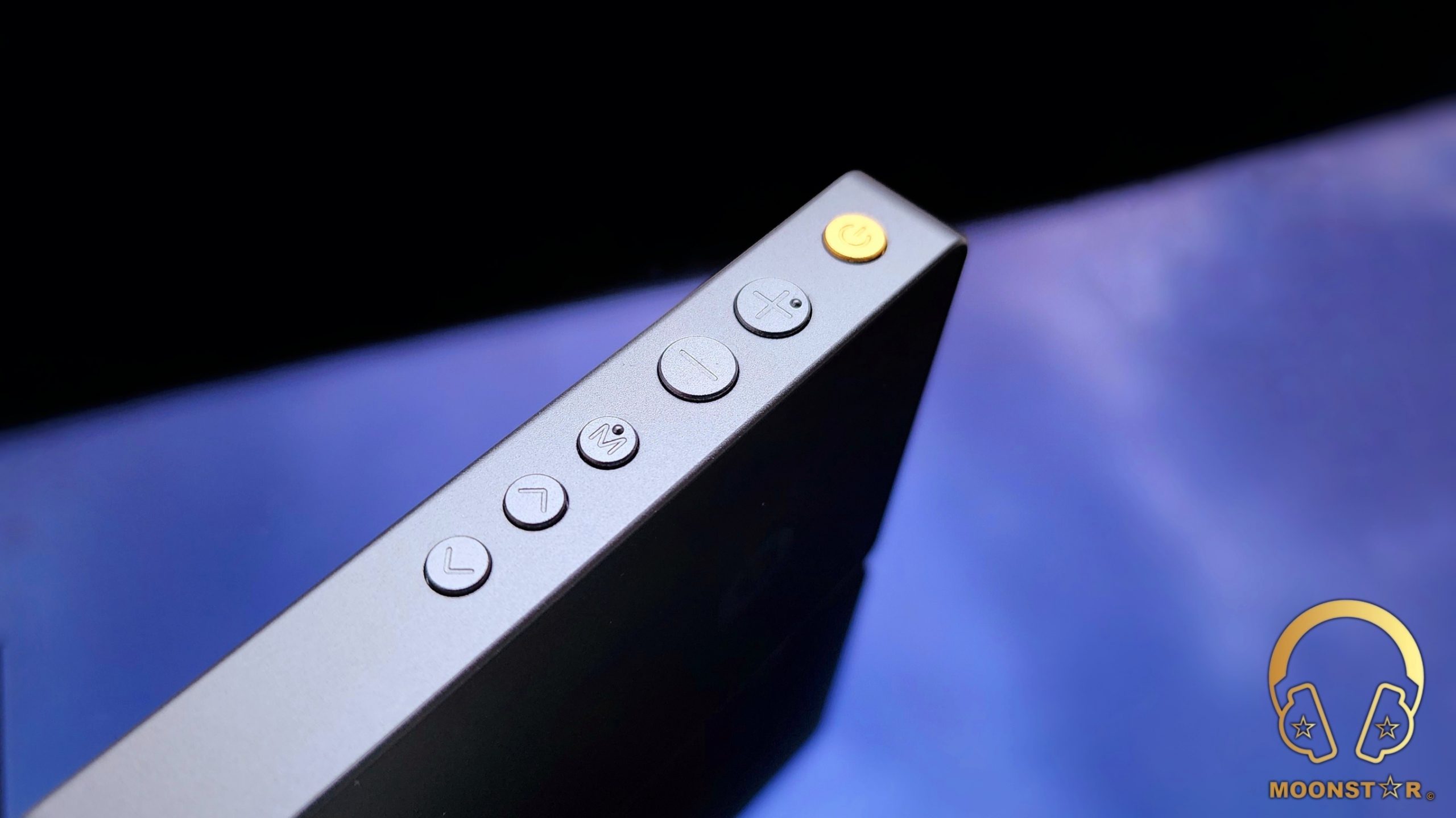
Midrange:
The midrange of the Quloos MUB1 is attracts attention with its pretty realistic and organic timbre both while listen to instruments and vocals. The general presentation of this area is extremely transparent, engaging and revealing. There is a slightly amount of warmth that is not overdone. The lower midrange is able to create a decent sense of fullness that was audible while listen to male and female voices, as well as instruments such like strings, pianos and percussions. Male vocals from Sting to Barry White are shown with pretty natural sense of body and depth in this area.
The Quloos MUB1 delivers a stunning performance in the upper midrange, where it showcases its superb resolution, extension and naturalness. It inherits the same distinctive tuning that I have always admired from previous Quloos devices, such as the QA361 and MC01. The MUB1 strikes a perfect balance in this region, blending a presentation that is neither too analytical nor too analog, but rather captures the essence of both worlds. Female vocals, such as those of Adele, Edith Piaf or Diana Krall, sound enchanting and lively, while instruments are rendered with vibrancy and realism, especially when paired with IEM’s and headphones like the Moondrop Blessing3 and HiFiMAN Edition XS.
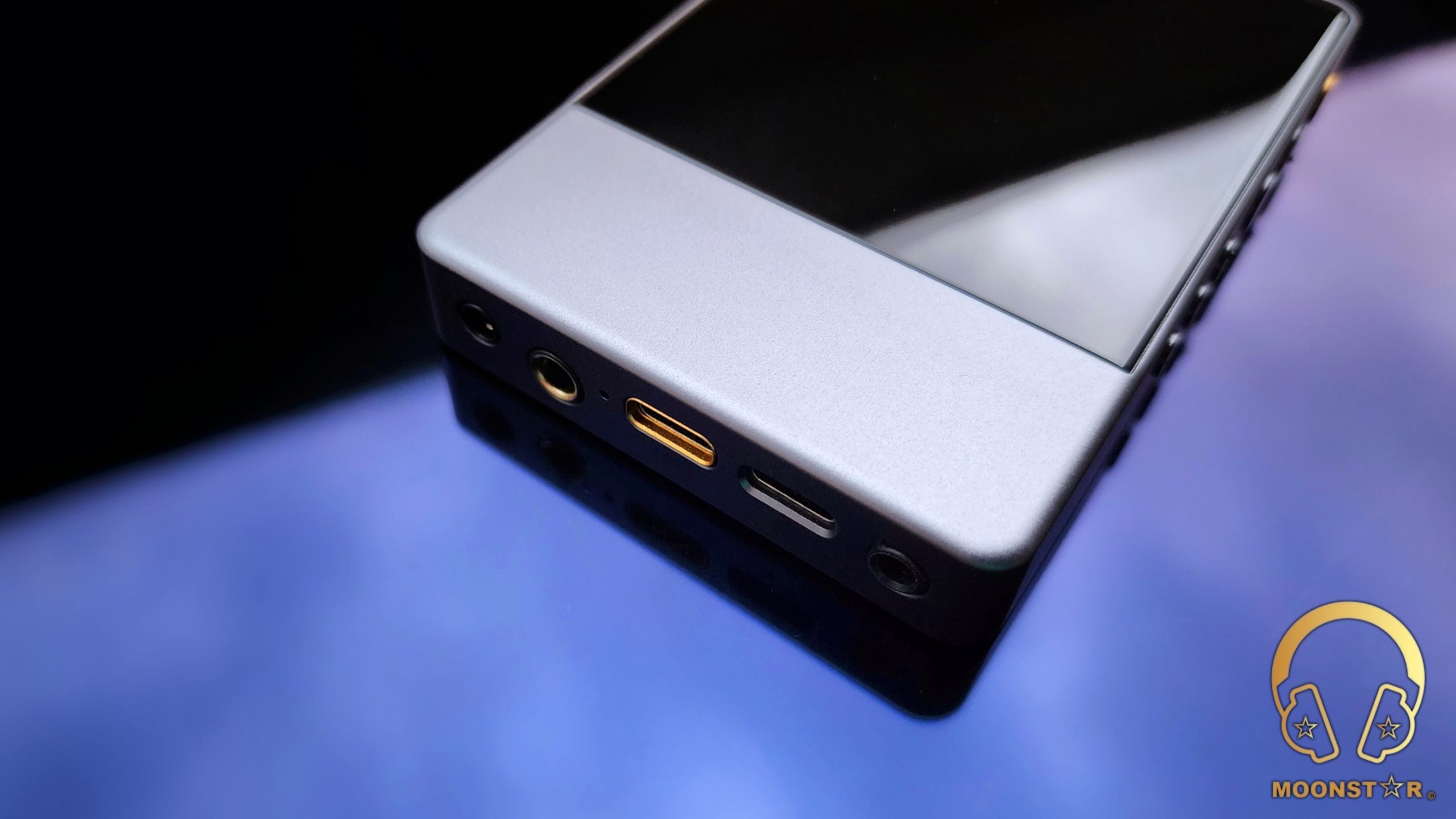
Treble:
The Quloos MUB1 offers a natural and smooth treble performance that has a touch of warmth, adding a pleasant coloration to the sound. The MUB1 has an impressive level of resolution and extension for a device of its size and price range, which is evident with any IEM or headphone that I have paired with it. The MUB1 delivers a clear and refined treble sound that will satisfy audiophiles who appreciate detail and realism.
The lower treble range of the Quloos MUB1 has a good sense of presence and a high level of clarity and definition, which makes string instruments, pianos, and soprano voices sound lively and realistic. The MUB1 handles the lower treble region with finesse and accuracy, avoiding any harshness or congestion that might affect the sound quality. The MUB1 renders the upper treble region with a good amount of airiness and sparkle, without being harsh or sibilant. Instruments like strings and percussions do sound detailed and realistic, while a hint of warmth prevents them from sounding too sharp or thin.
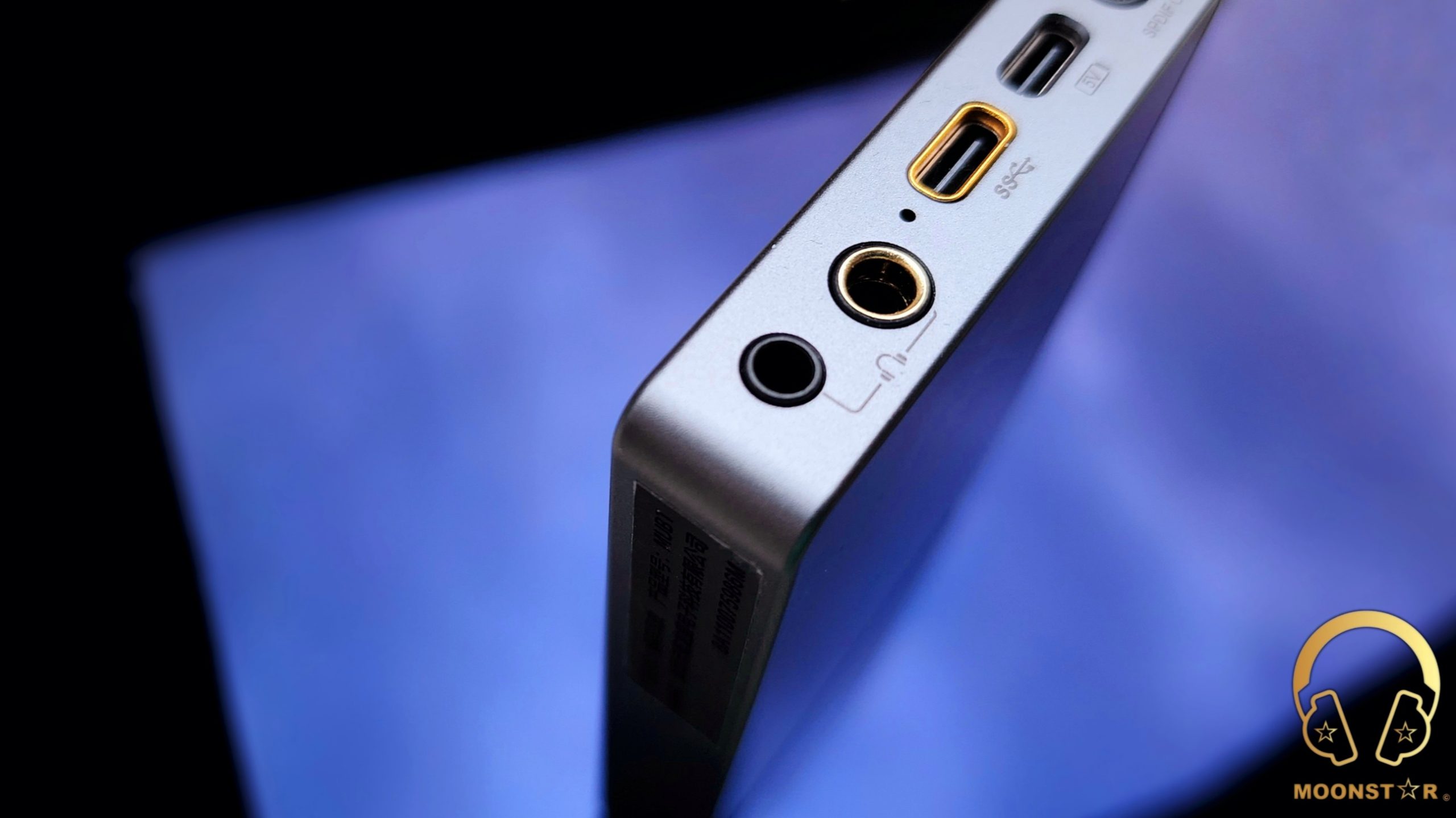
Soundstage & Imaging:
The Quloos MUB1 has a spacious and airy soundstage atmosphere that creates a realistic and immersive listening experience. The background of the device is very dark and clean, which enhances the precision and separation of instruments and vocals. The soundstage of the MUB1 has a good level of depth and wideness that creates a decent sense of spaciousness and dimensionality.
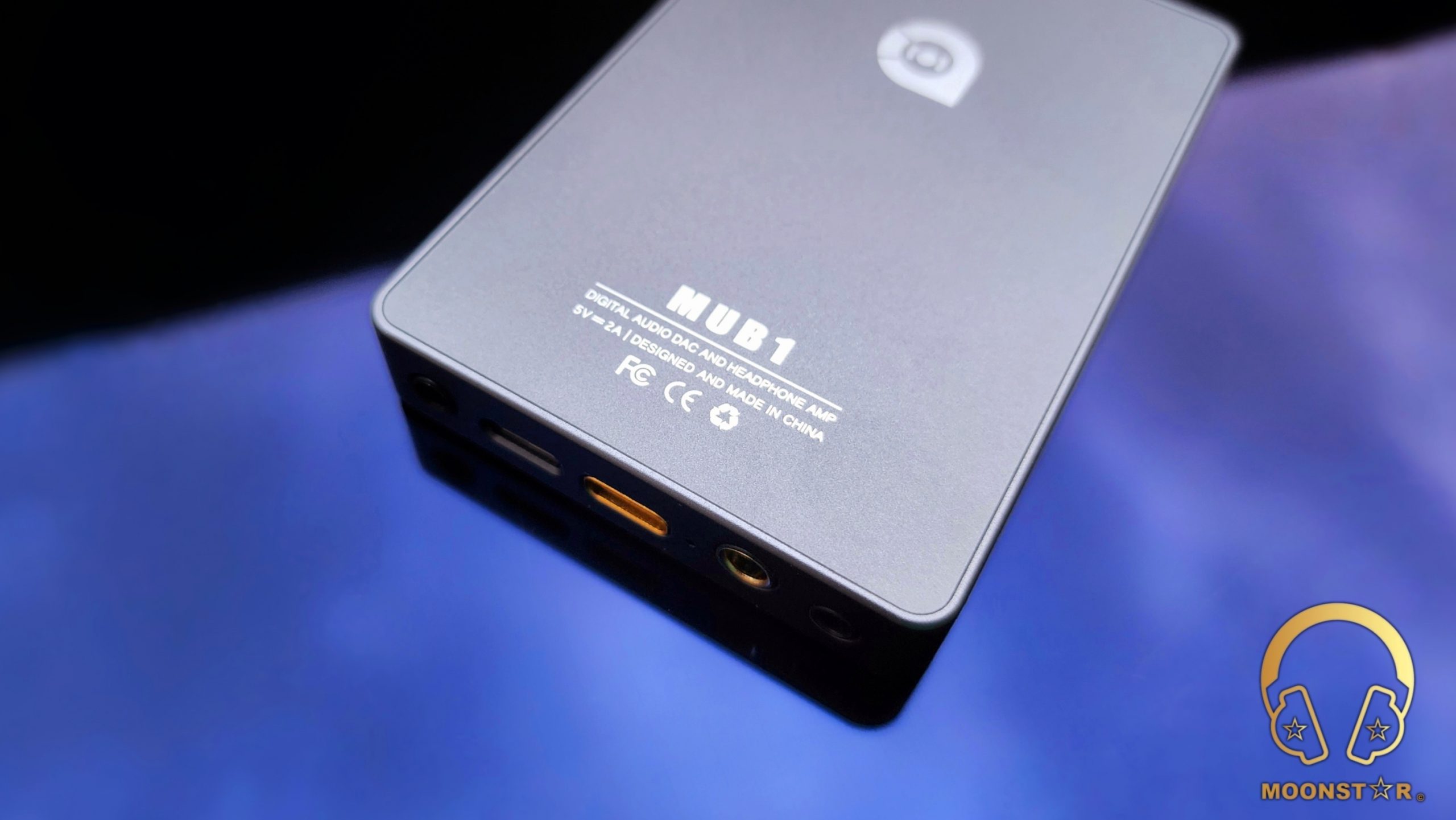
Conclusion:
The Quloos MUB1 is an All-in-One Portable audio solution that delivers a stunning sound performance in both wired and wireless modes. It is equipped with four high-performance DAC chips and four amp chips that can drive various headphones and IEM’s with ease and accuracy. Moreover, it supports multiple Bluetooth codec’s, including the high-resolution LDAC, and has a built-in battery that can even charge your phone if needed. What I also really like is its sleek and compact design, equipped with a small but useful OLED screen and multiple hardware buttons, and output/input options. All this features makes the MUB1 to a versatile and powerful device that can serve as a portable USB DAC/AMP and Bluetooth player that will satisfy the needs of any audiophile who values sound quality, convenience, and functionality.


